
Taiwan Birding Trip Report, July 8-16 2023 Callyn Yorke
Scroll down for the Annotated Bird List
INTRODUCTION
A visa renewal cycle was approaching and it was time to look for a new birding destination in the Asian region. My Vietnamese partner, Da Thao, suggested Cambodia or Thailand. Either of those destinations would be short flights from Saigon, the closest port of entry to our home in DaLat, located in Vietnam’s south-central highlands. Naturally, I was more interested in seeing a new country than revisiting our nearest regional neighbors. Taiwan seemed perfect; civilized, safe, affordable, a 3.5 hr. direct flight from Saigon, and best of all, a stunning array of endemic species, all of which would be lifers for Thao and I. What could possibly go wrong?
Things went fairly well for us, actually. Taiwan, like Singapore and Japan, is highly organized, efficient, clean and environmentally pro-active. Litter, for example is rarely seen on the streets. Cigarette butts accumulate in dedicated receptacles, strategically placed along sidewalks. Dog poop must be collected immediately by the dog’s owner. Except for humble monks in gray robes, beggars and homeless people were entirely absent from public view. Bewildered tourists out for a casual, explorative stroll, are swept into columns of pedestrians and cyclists, moving like determined driver ants controlled by red/green-man traffic lights and countdown clocks. Three, two, one and GO! You have 90-seconds to make it across a 50m intersection as hot as molten lava. In sixth grade, I recall, the fastest kids could do that distance in six seconds flat. Nowadays I might make the dash in about ten seconds, and finish a little short of breath. After making a few crossings, Thao and I learned that it probably wasn’t safe to begin crossing an intersection in Taipei with less than fifteen seconds remaining on the clock.
Taiwanese conform to a particular social standard, some globally fashionable, e.g. tattoos on exposed limbs of young folks; some subtle and ethnocentric, e.g. fair-skinned Asian women using umbrellas on partly cloudy days. All city-goers are expected to obey traffic laws, make legal U-turns, observe one-way streets and navigate public transportation. No one is out of line; no one butts ahead in line. Behavioral regulations are posted at each and every public facility. Surveillance cameras are ubiquitous. Like a dutiful shepherd, the government is alert and watchful. There aren’t many opportunities for folks to deviate.
Public parks, and ‘green spaces’ were numerous in Taipei and were convenient locations for some sort of stress relief. Not surprisingly, those places were heavily used. But even there, with trees and fresh air, more behavioral guidelines were posted. Each park had their own set of rules; the Taipei Botanical Garden had particularly pointed regulations regarding noise and pets, which helped explain why birding was really outstanding there.
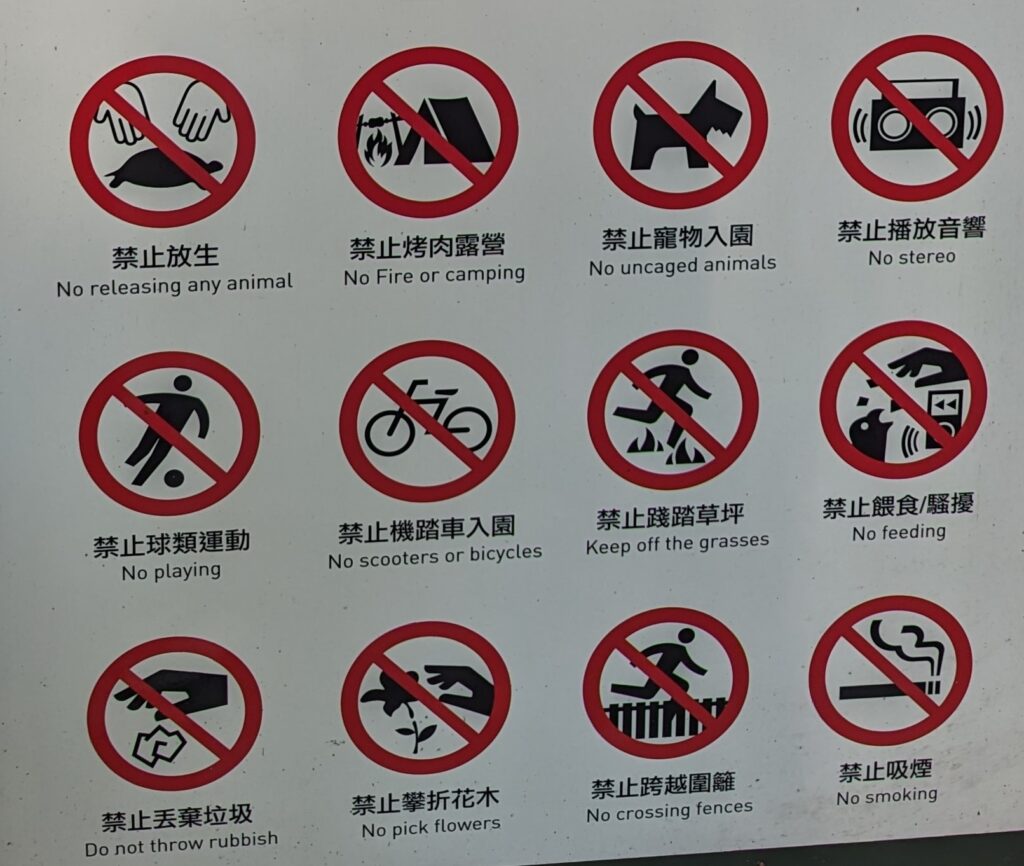
All of this, Thao and I found to be quite a change from the adaptive ebb and flow of life in a Vietnamese city, where the only apparent rule in the driver’s handbook is, Dude, Don’t Hit Anything. In fact, our home city of DaLat (pop. 425,000) only recently installed its first set of traffic signals downtown, which pedestrians and many motorbike riders simply ignored. In Taiwan, rules are apparently enforced. Everyone, without exception, is expected to know and follow them. Outlaws are quickly apprehended by police and locked up. Crime on the streets of Taipei is unheard of (but that may be somewhat untrue if you speak Chinese). The bottom line is that visitors to Taiwan are probably going to be perfectly safe.
Things were not always so simple and predictable for us in Taipei. For instance, we encountered a significant language barrier, which was sometimes an awkward inconvenience, though usually surmountable by recruiting a young Taiwanese bystander. Generally, Taiwanese under thirty years of age could speak a little English, enough so as to help us find places of interest and conduct simple transactions. Most of the folks working at the Dolamanco Hotel (Government rated 3-Star; $US 80 per night) were very helpful arranging local transportation by taxi, e.g. from the the hotel to the Taipei Botanical Garden (4.0 km, averaging $US 6.70 each way).

Cheerful desk clerks at Dolamanco translated our destinations into written Chinese characters, which was handed to the taxi driver. Drivers, who spoke little or no English, used GPS on their dash-mounted cell phone and navigated to the correct location without a problem. Confusingly, however, my three visits to the Taipei Botanical Garden, resulted in six different routes taken by the drivers and each with a slightly different fare (+/- $US 0.75).
The biggest issue we faced was our differing agendas. Thao was mostly into sightseeing, portrait photography (euphemistic for selfies) and shopping. For her, and presumably for the majority of Vietnamese citizens, just getting into Taiwan was a very big deal. For reasons that probably have origins in post-war political difficulties, many Vietnamese are still denied entry into countries where there is an obvious economic incentive to overstay their visa. Fortunately, since Thao had already visited South Korea, Malaysia, Singapore, Thailand and Indonesia, and she would be traveling with me (an American), her Taiwan visa application was readily accepted, though restricted to fourteen days (I received a ninety-day visa upon entry). Taiwan would be another favorable stamp in her passport that could help her obtain travel visas for other countries.

New birds were fun (eBird listed 588 species for Taipei City) but they would ultimately be defeated by a frontline of Taiwanese fortifications, palaces, temples, department stores, souvenir shops and cafes. A stormy debate was brewing in Room #605 of the Dolamanco Hotel. Thao and I needed a compromise. The one thing we wanted to avoid was another protracted Vietnamese-American disagreement. Historically, the previous one did not fare well for either side.

Happily, we negotiated a cease-fire, resolved our differences and ended up quite pleased with our brief visit in Taiwan. I had done a little research online and discovered quite a few potential birding sites in Taipei, where we would be based for eight days. It was no coincidence that Hotel Dolamanco was chosen – across the street from one of the top birding sites in Taipei, Da’an Forest Park, visible from our 6th floor hotel room. Most of the other birding sites, as well as places of interest for Da Thao, were within walking distance or a short taxi ride from the Dolamanco. As far as we were concerned, Dolamanco rated 5-stars for the quality of our fully upgraded room, friendly service and location.
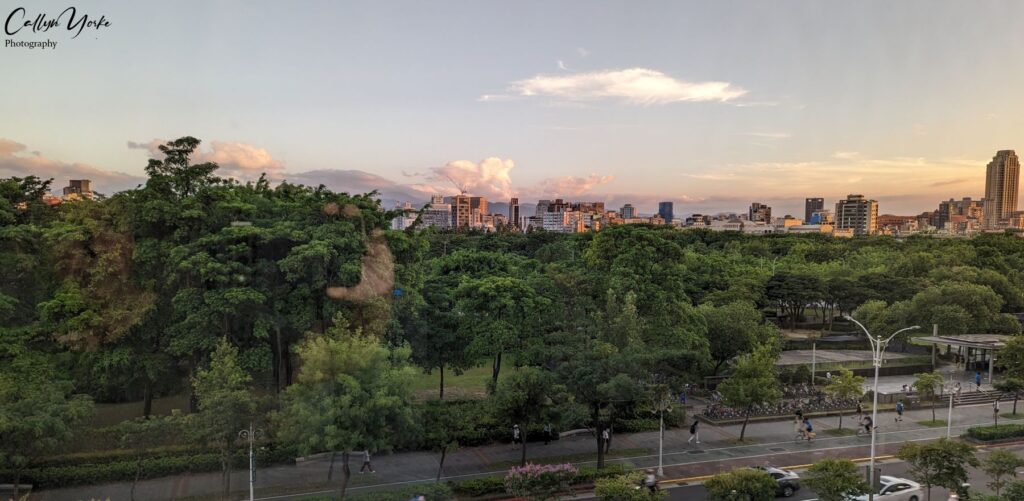
Taipei has an extensive public transport system, composed of modern buses and trains (MRT). Fully automated bicycle rental stations are everywhere. However, due to problems interpreting Chinese characters (neither of us had a clue how to read them) and the paucity of maps and signs in English, we found it easier to take a taxi, rather than wander through the city hopelessly lost on a bus or MRT. Conveniently, we found restaurants and other places of interest within walking distance of the hotel. The nearby Yong Kang district, with many small shops, including an excellent Vietnamese restaurant (Thanh-Ky), became our favorite place for lunch.
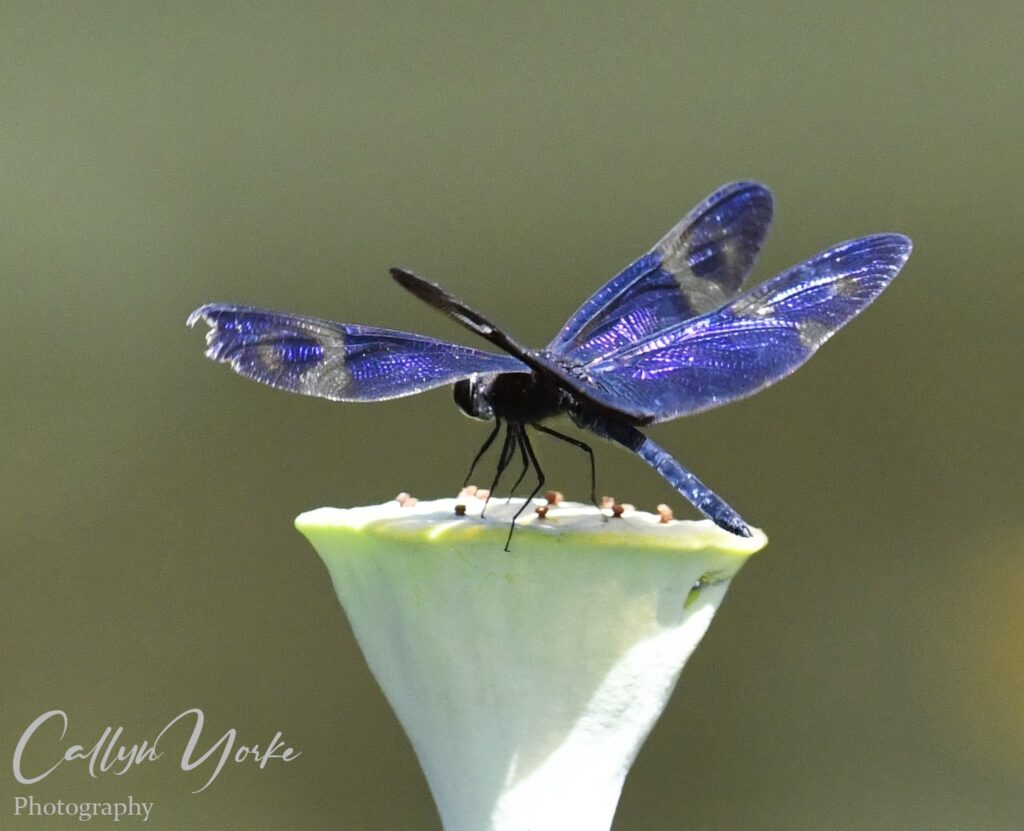
Having eight full days of predominantly fair weather (ambient night/day temperatures normally ranged from 28°C to 34°C), with increasing clouds and occasional thundershowers in the evening, I was able to complete multiple early morning and late afternoon surveys of Da’an Forest Park. I made three morning surveys of Taipei Botanical Garden. Distant locations, i.e. Yangmingshan National Park, Guandu, Huajiang Wild Duck Park and National Chengchi University, were visited only once. I also kept notes from our daily walks and visits to historic sights in Taipei, e.g. Taipei National Theater. Bird survey locations, described in detail in the following section, are shown on Google street maps; each location is given an abbreviation used in the Annotated Bird List, found at the end of this report.
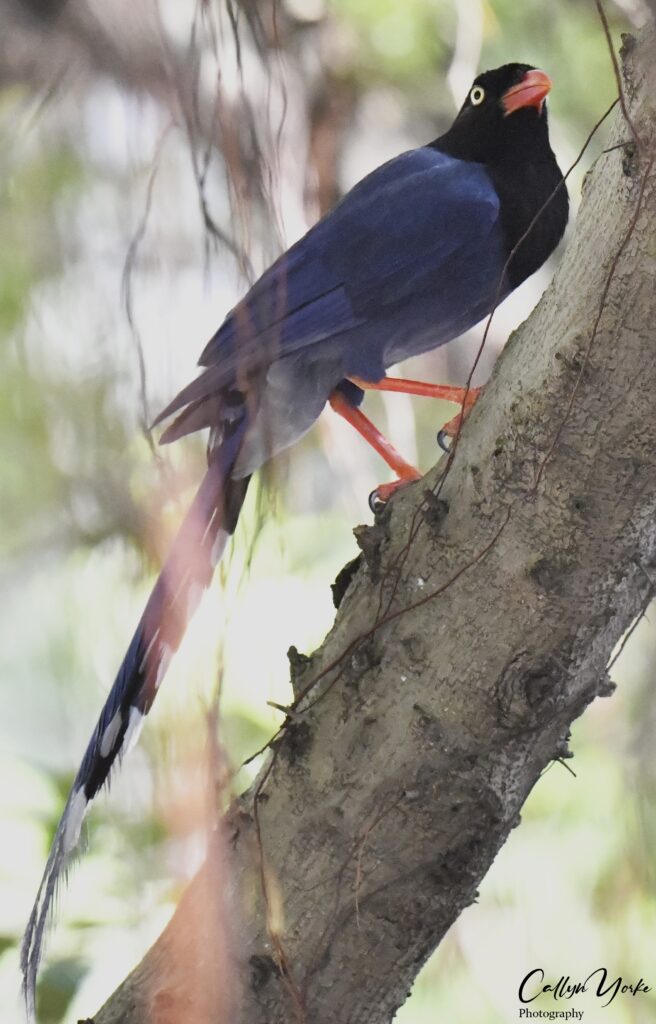
I was keen on finding endemic bird species at the above locations; several produced at least one or two such species, most commonly Taiwan Barbet, which was often broadcasting a monotonously repetitive, rather unmusical phrase (typical of barbets), while well concealed somewhere in a tree canopy. Locating and photographing that bird proved to be a challenge.
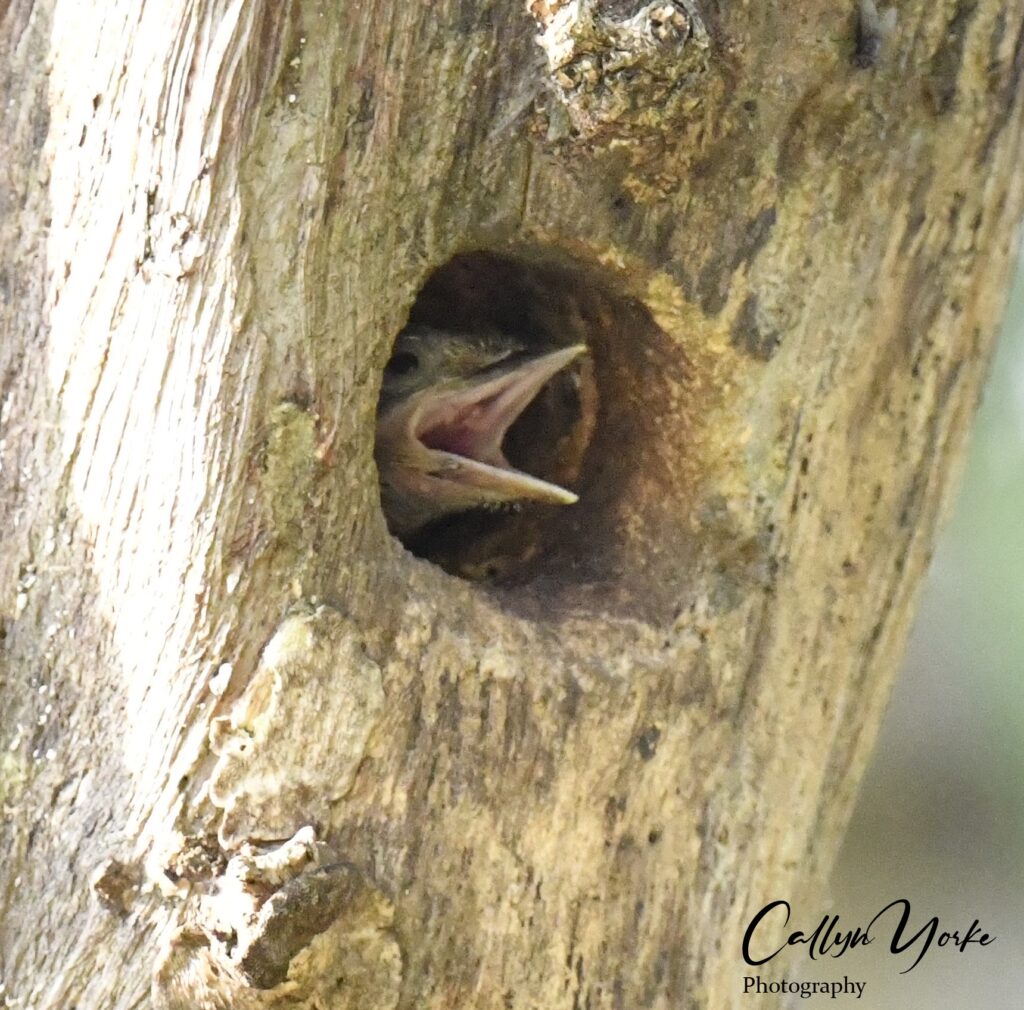
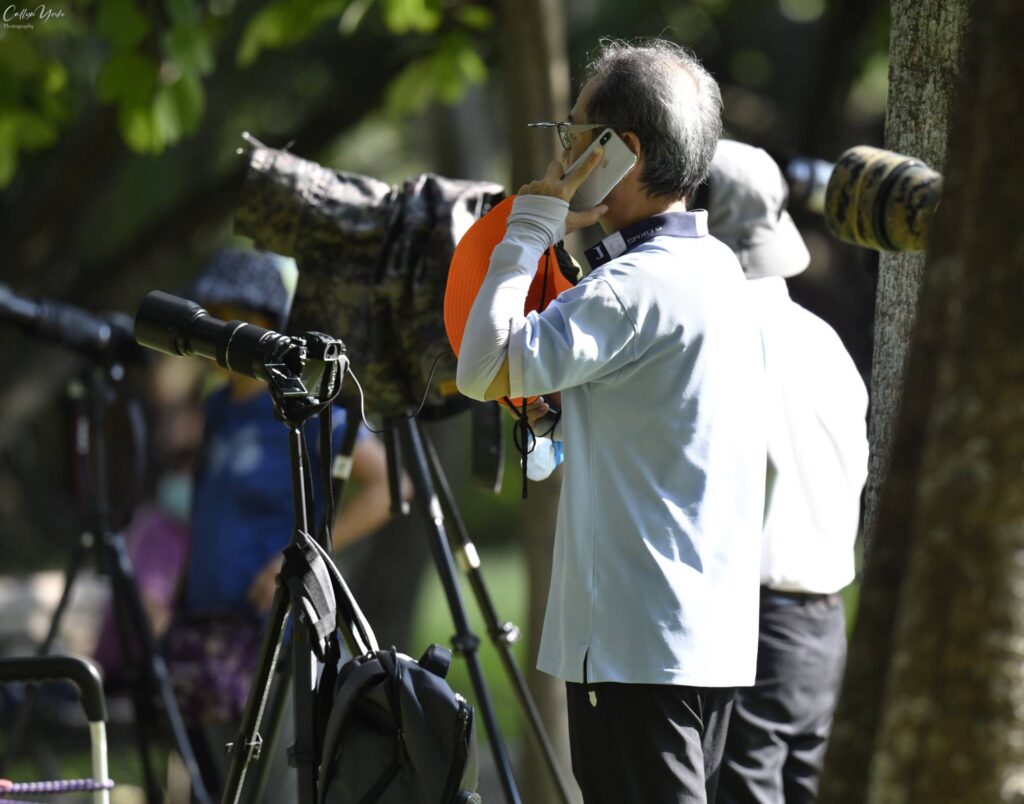
On two afternoons, I briefly joined an ad hoc committee of local photographers, who had staked out a Taiwan Barbet nest cavity, patiently awaiting the return of adults with a food item. Not much luck with that, for either the photographers or the youngsters in the nest. Grimly determined and nearly exhausted from the afternoon heat, I chanced upon an individual barbet on a low limb, wrangling a mantis, which provided a brilliant opportunity for close-ups.
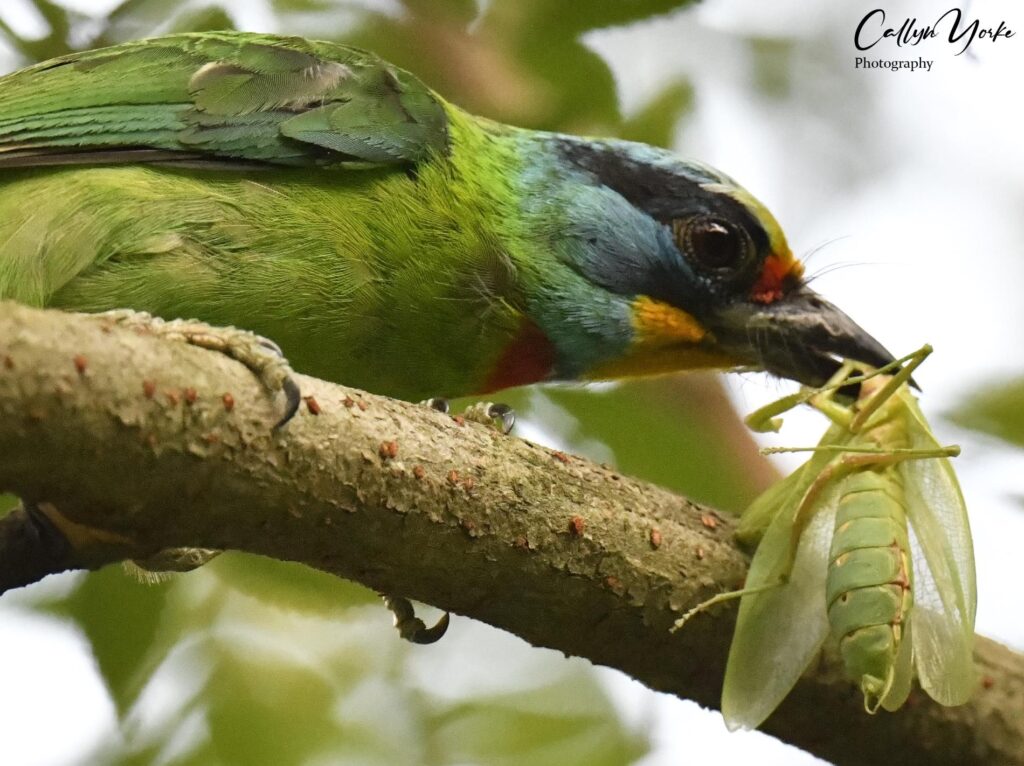
Taipei parks and nature reserves supported interesting animals in addition to birds. At two widely separate locations (Da’an Forest Park and National Chengchi University), I found a slender, arboreal lizard resembling those in the genus Calotes, a widespread and fairly common group of diurnal lizards in Southeast Asia. But I was skeptical about assigning this new found lizard to Calotes; the head shape and scale patterns didn’t quite match up. After returning home, I reviewed my photos and, comparing them with online photographs of similar specimens from Taiwan, determined that it was a good match for a Taiwan endemic known as Swinhoe’s Tree Lizard (Diploderma swinhonis). The lateral yellowish stripes on the adult male is apparently a reliable field identification mark.
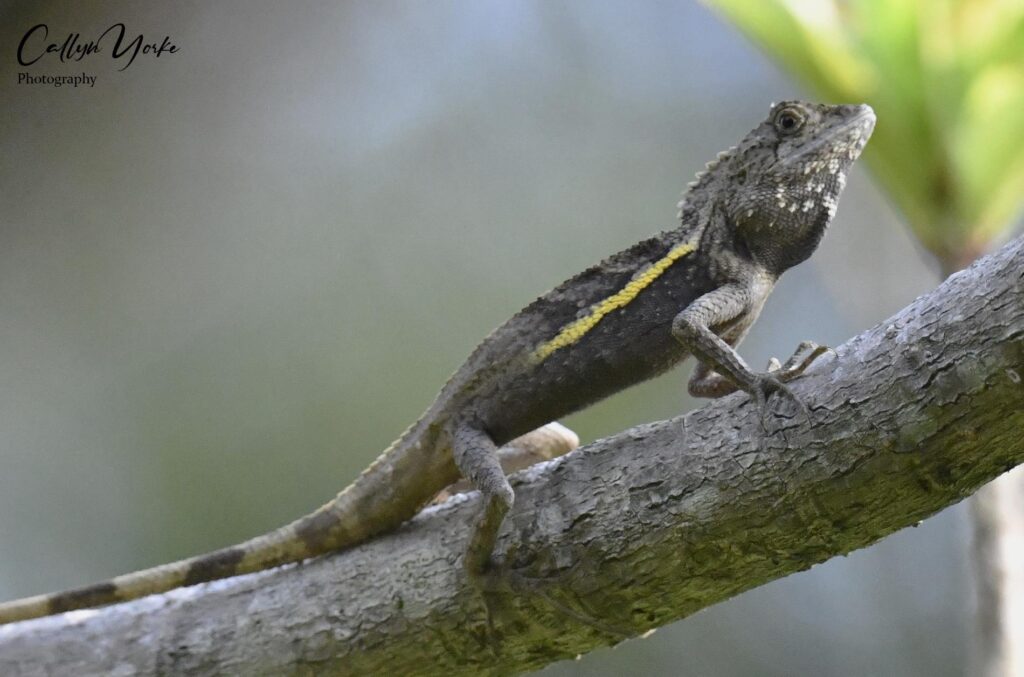
Another delightful surprise was the discovery of a population of mudskippers flopping around on tidal mudflats near Guandu. I had seen these curious, semi-terrestrial fish many years ago on distant mudflats along the west coast of Peninsular Malaysia; yet never in such numbers and density as in this particular riverside locality. At least fifty adults were visible in an area of about 0.25 hectare. For the first time in my life, I was able to get close enough for identifiable photos of these remarkable creatures. I struggled to hold the camera steady, slowly creeping forward in the soft, sticky mud. The sharp-eyed mudskippers were probably aware of my presence, and by correctly calculating my weight and mud-sinking coefficient, confident that I could not possibly reach them before making a quick retreat into a burrow, their version of a panic room.

Mudskippers are thin skinned and suffer from a taxonomic identity crisis. They are not only comically cute, they are, in many respects, biologically enigmatic and seriously unfish-like. Check this out. Biologists have discovered that, If kept moist, these fish can live out of water for extended periods (20-60 hours), breathing air trapped in enclosed opercular and buccal cavities; a backpressure valve helps store water for osmoregulation. Like frogs and salamanders, mudskippers have highly vascularized, subcutaneous epithelium, retaining sufficient moisture for gas exchange (cutaneous respiration).
Mudskippers get around on land just fine. Using their outsized pectoral fins and flexible, spring-like trunk muscles, these acrobatic little fish can literally hop, skip and jump over the mud, dive back into the water in a heartbeat, or into a convenient burrow, where, with a bubble of pharyngeal air, they take refuge from fully aquatic predators at high tide.
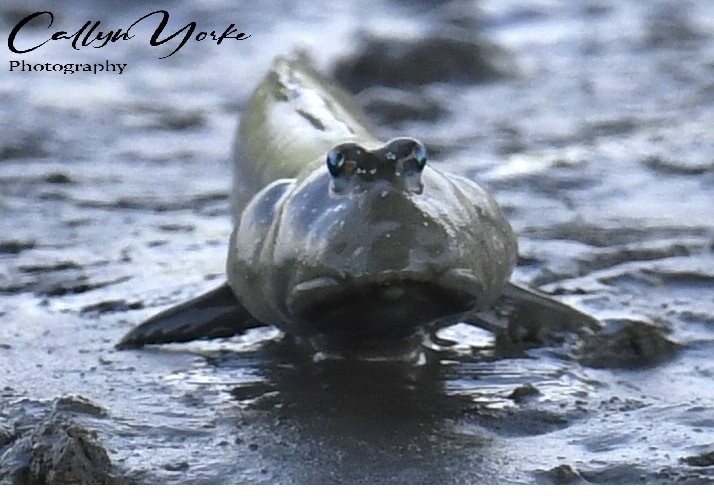
Very circumspect they are too, blinking with a unique pair of elevated, retractable, rotatable, green eyes, almost like a chameleon. Tiny ocular muscles control the shape and position of the cornea and lens, allowing visual accommodation in air and water. A mudskipper comes about as close to being a card-carrying amphibian as any living fish could ever be. Rewinding the geologic clock about 370 million years, mudskippers are a contemporary example of how ancient fish could have behaviorally, morphologically and physiologically, evolved into amphibians. Finally, I absolutely love the descriptive Latin binomial given to this species, Periophthalmus modestus. Say it twenty times and its yours forever.
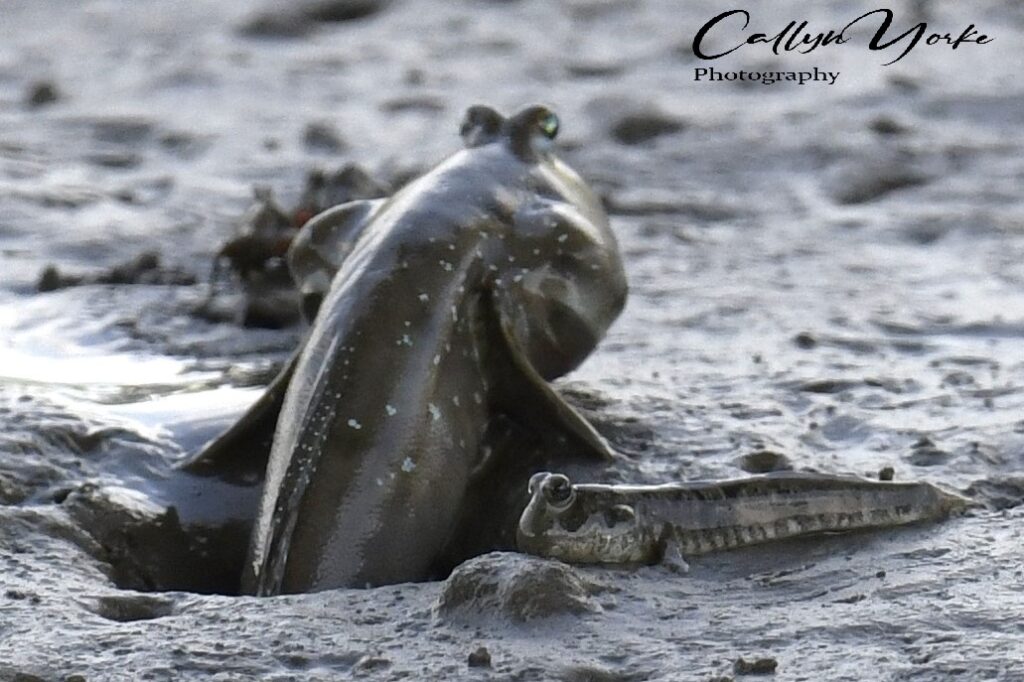
At the end of eight days of field work in Taipei city parks, I arrived at two conclusions regarding the birds. First, the results from multiple surveys in Da’an Forest Park and the Taipei Botanical Garden, indicated that birds were frequently moving in and out of the parks; bird species frequency and abundance were unpredictable variables. As in my college classes, individuals might be present and accounted for one day and inexplicably absent the next. Unless an active nest was found, It was hit and miss, in terms of locating endemics and other birds of special interest. The obvious question was: Where were all these birds going?
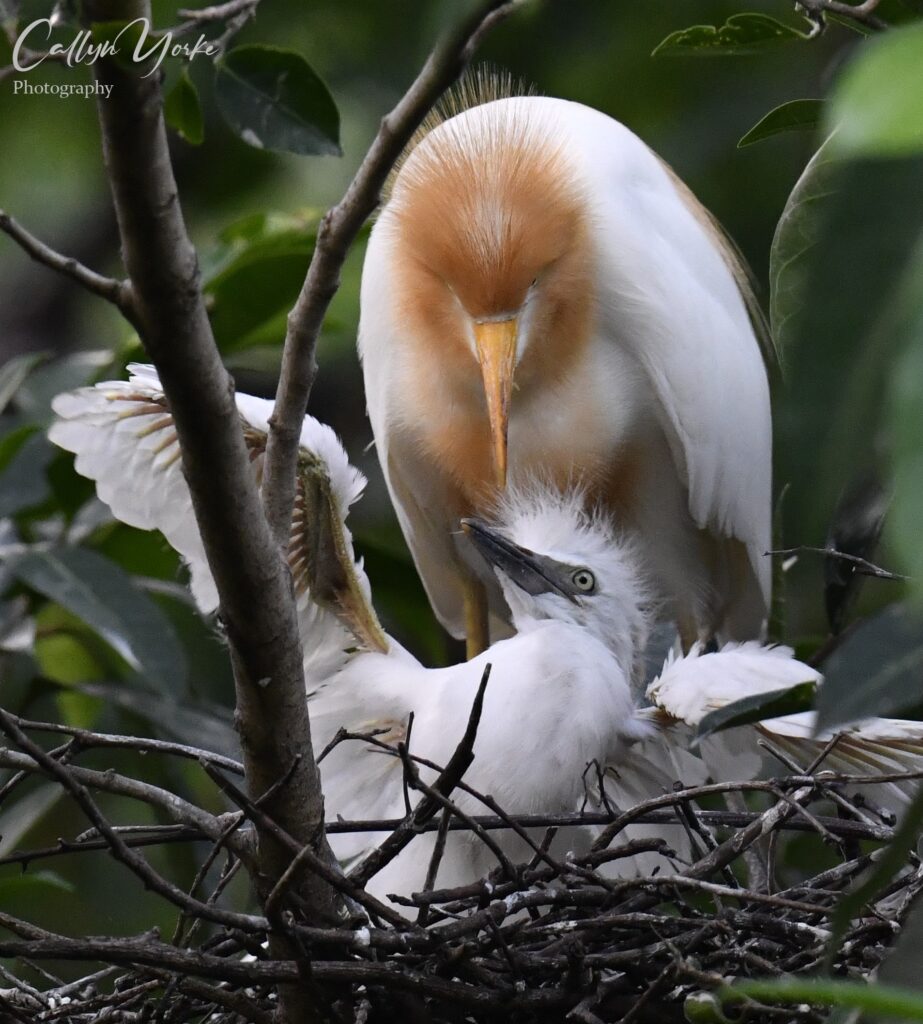
Maps of the greater Taipei area (see below) show a high density of natural “green” areas, varying in size and habitat heterogeneity — two ecological variables that are often reliable predictors of avian species diversity and stability. Some places, e.g. the forested hills above National Chengchi University, and Yangmingshan National Park, may serve as wildlife refugia.
From those comparatively large, heavily forested areas, birds may disperse, wandering through an archipelago of smaller habitat islands in the city, searching for sustainable resources. Since most of the parks were more or less managed, i.e. regular mowing, tree-trimming and clearing of unwanted vegetation, birds might settle in a spot, only to be served an eviction notice a few days later by groundskeepers. Survivors in those situations would necessarily be highly mobile, opportunistic, often homeless species, quickly locating and utilizing a variety of available resources.
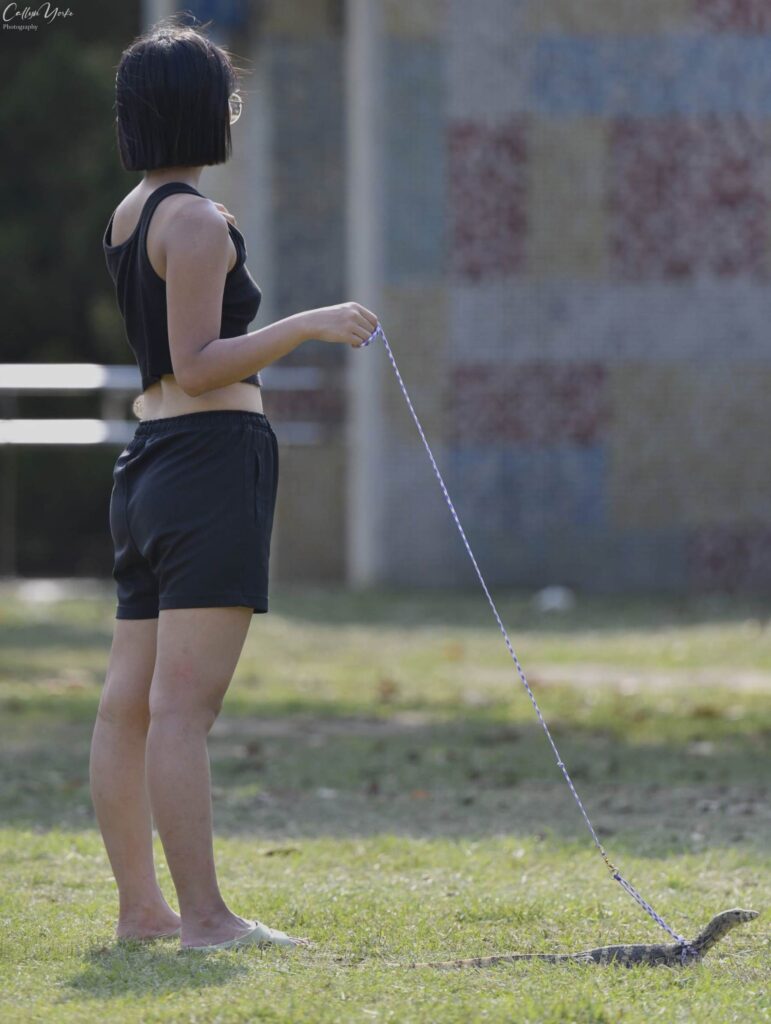
Secondly, Taipei city parks, at least the few I visited, were massively used by locals, sunrise to sunset, everyday. Often, in Da’an Forest Park, I had to step aside for pedestrians, joggers, dog-walkers, lizard-walkers, hand-clappers, arm-wavers, barkers (people shouting periodically for no apparent reason) and others completing their daily, stress-reducing routines. Quiet areas where one might expect to find an interesting bird or two, often contained people posturing like mimes, which earned them the honorable designation, ‘Frozen Yogis.’ Da’an Forest Park usually had loudspeakers set up for yoga and exercise classes each morning. Leaf-blower brigades marched along the numerous paved pathways. Clearly, for a bird species to settle in such a busy, dynamic environment, it must have a relatively high level of tolerance for a varied repertoire of human theatrics.
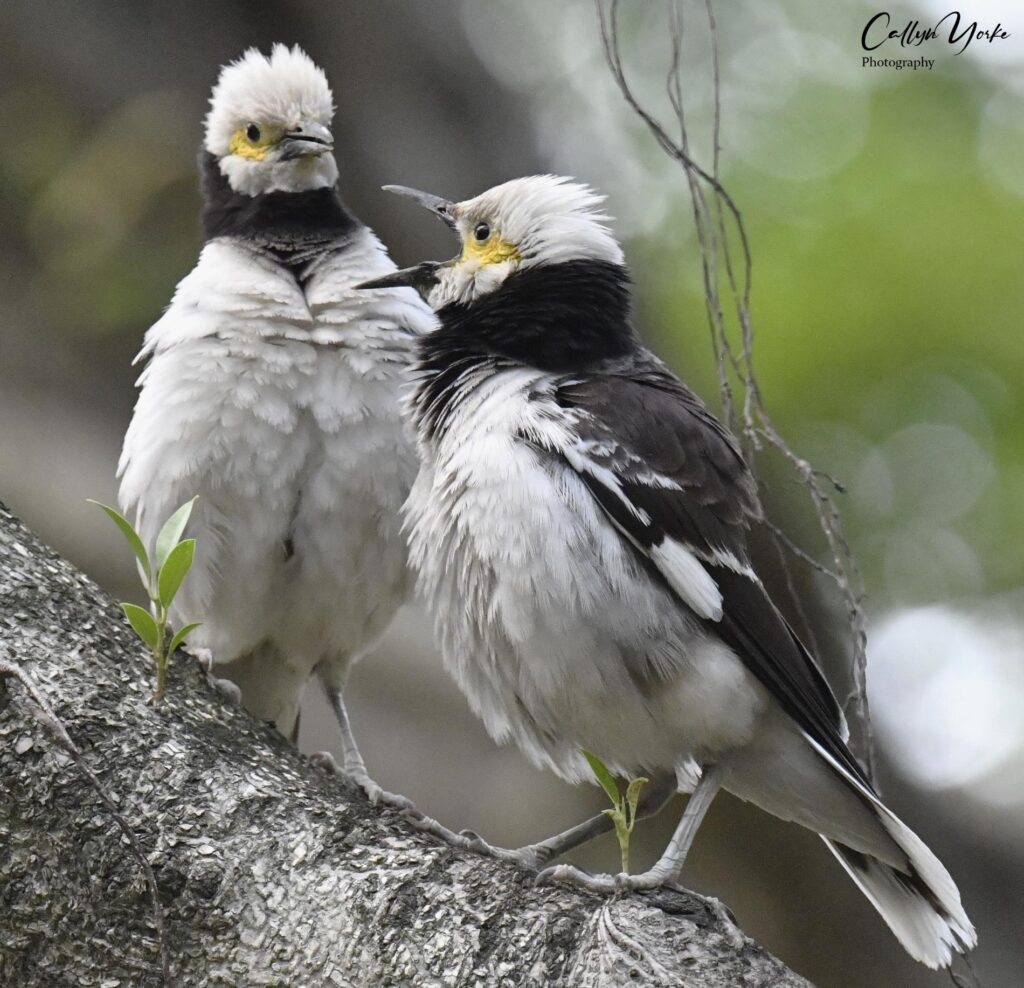
Among the most frequent bird species found in the parks, were two introduced (exotic) representatives of the diversified and widespread starling-myna family (Sturnidae). Combinations of three related species in this group occurred in the parks, e.g. Javan Myna and Common Myna; Black-collared Starling, possibly from a heterogeneous population of introduced and naturally colonized birds, was common in Da’an but not observed in Taipei Botanical Garden. Crested Myna, evidently now rare in Taiwan, was found during a single survey of Huajiang Wild Duck Park. Characteristically, starlings and mynas were observed utilizing a variety of foods, including seeds, fruit, arthropods and (rarely) discarded food scraps. Nesting presumably occurred in neighboring multilevel buildings, bridges, overpasses and other elevated structures, from which the birds commuted to and from the parks.

Similarly, pigeons and doves (Columbidae) and magpies (Corvidae) were regular ground-feeders on lawns and walkways. Among the most commonly found were, Feral Rock Pigeon (exotic), Oriental Turtle Dove and Oriental Magpie.
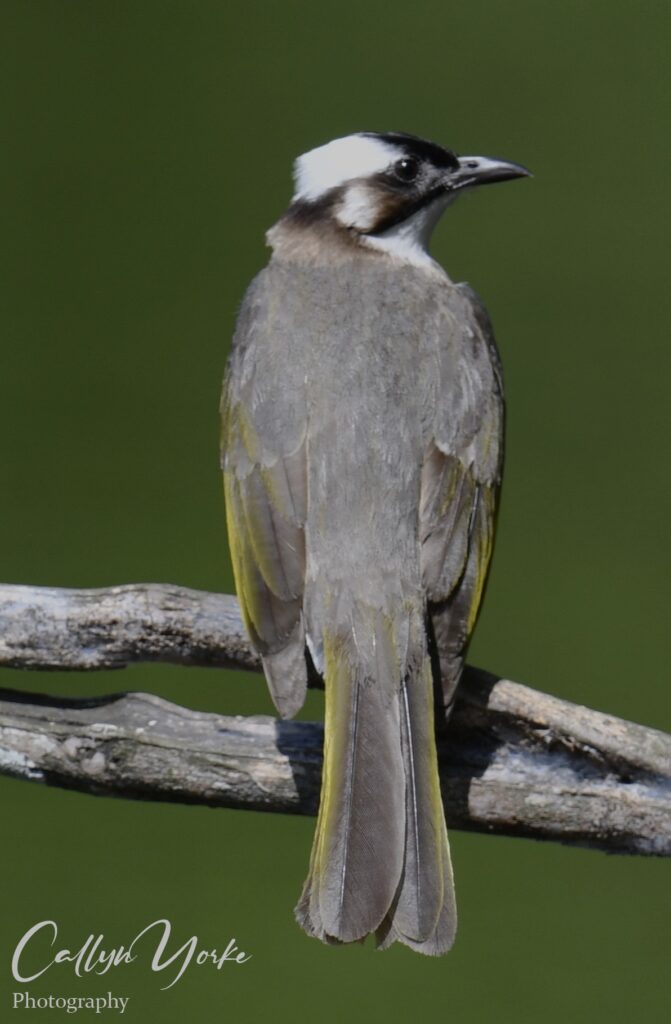
Another noteworthy bird species, present in nearly every park I visited, was Light-vented Bulbul. This widespread, East Asian commensal was habitually vocal, gregarious, and opportunistic — foraging on flowers, fruits, seeds and arthropods at all levels, from the ground to the loftiest tree canopies. Their persistent scold calls alerted me to the presence of an occasional raptor in the park, Crested Goshawk. Joining the bulbuls gleaning small insects from the foliage of shrubs and trees, were flocks of Swinhoe’s White-eye, one of the commonest birds in Taipei.
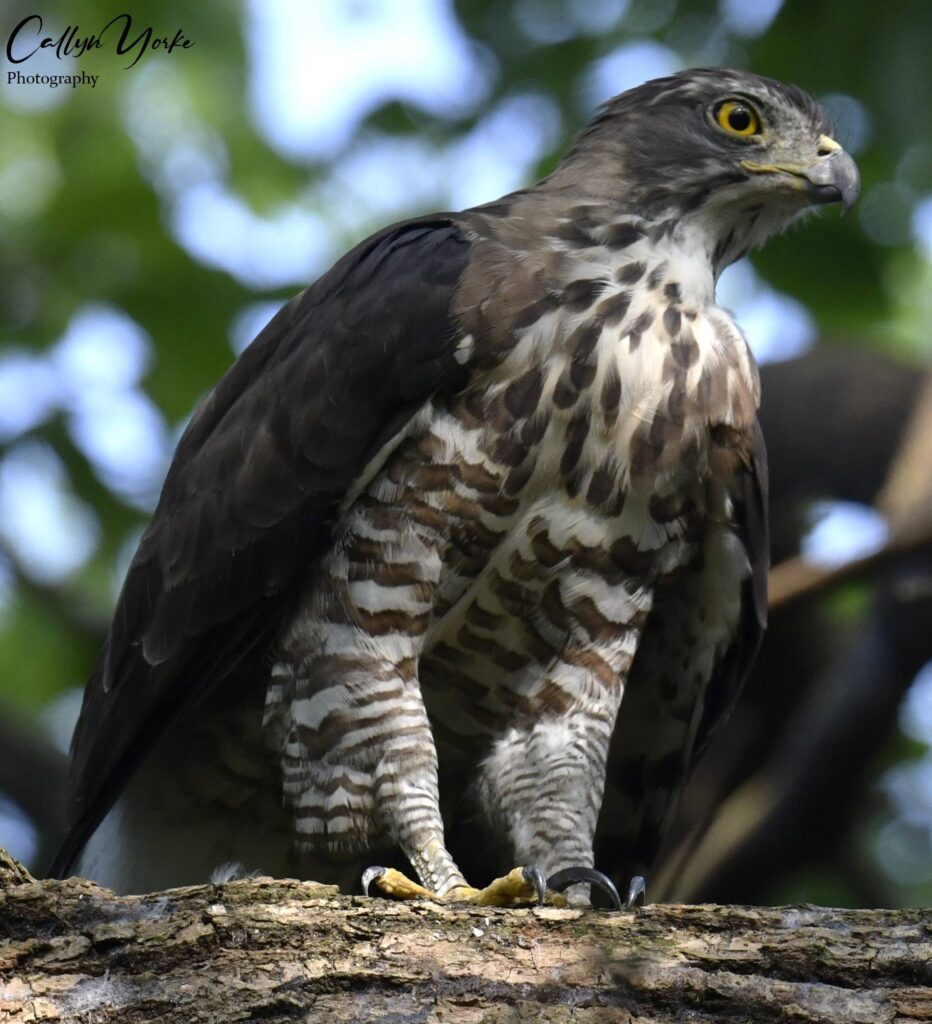
Although likely regarded as a slam dunk for local birders and visitors who have done their homework, I was nonetheless thrilled to photograph Malayan Night Heron in a Taipei city park. Generally in southern Asia, this is a reclusive, nocturnal swamp-forest dweller, seldom seen even by experienced birders. In Da’an Forest Park (less commonly in Taipei Botanical Garden), it was easily found and observed at close range. Most were immatures (one young adult had tarsal bands for individual and cohort identification, apparently part of a scientific study – see Annotated Bird List). Solitary birds spent daylight hours slowly and methodically hunting small arthropods in the grass, often in clearings, evidently undeterred by the hoards of pedestrians and occasional photographer.
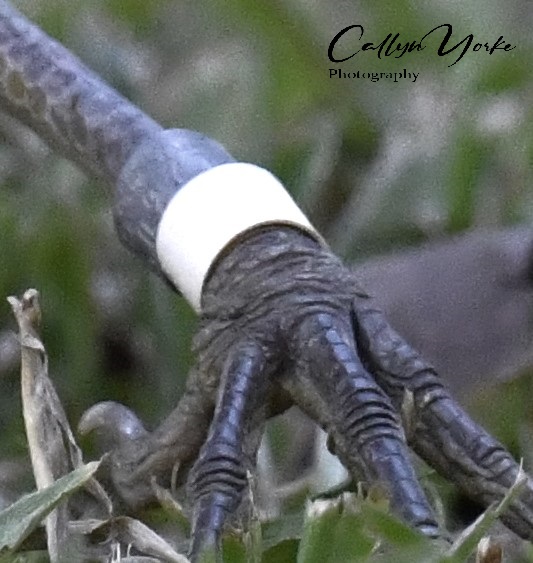
Assuming this ground-dwelling bird has a number of predators to watch out for in lowland rainforests, e.g. Reticulated Python and Clouded Leopard, the absence of such animals in busy city parks, where hunting and egg-collecting is strictly prohibited, may confer a measure of safety and security for birds that can manage to find suitable resources. In these areas, birds probably learn to associate people with safety and thereby become, depending on the species’ innate temperament, commensals of humans. This familiar association has been an incentive for animal domestication for thousands of years and probably antedates the earliest known civilizations.
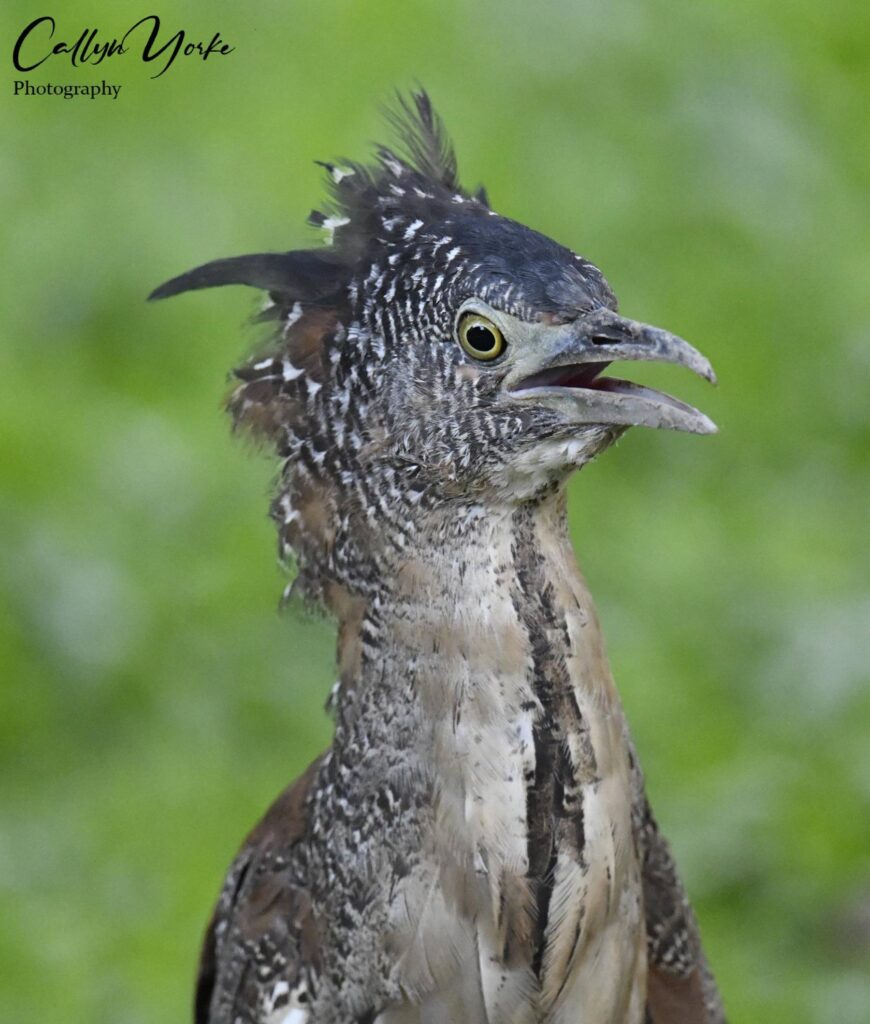
SURVEY AREAS, MATERIALS AND METHODS

The principal survey areas (each given an abbreviation) are individually mapped and described below, including dates and times of the visits. Map scales are approximate, as are the designated survey routes. Habitats are described in general, ecological terms; plant species were largely unidentified. Weather during the surveys was fairly consistent, ambient air temperatures 28°C to 36°C; skies fair to partly cloudy; winds, E, ENE, 2 – 8 kph.; brief thundershowers on the afternoon of July 12, 2023.
For all surveys, I used a 10×42 Zeiss binocular and Nikon D850 camera, fitted with a Nikon PF 500mm lens. A Google Pixel 7Pro cell phone camera was used to document habitat features and other items of interest. Field notes were recopied each evening into a loose-leaf binder, which formed the basis for the text portion of this report.
Da’an Forest Park (DFP). Six surveys: July 8 (1630- 1800 hrs. with Da Thao Le Nguyen), July 9 (0540-0720 hrs.), July 10 (1540-1730 hrs.), July 12 (1605- 1810 hrs.), July 14 (1605 -1800 hrs.), and July 16 (0650-0840 hrs.).

I walked variable routes, generally in a clockwise pattern, on paved and unpaved paths throughout the park, beginning and ending at the northeast park entrance, across the street from Hotel Dolamanco. Hundreds of people were in the park during my bird surveys, including photographers and (once) two other birders (individuals using binoculars). Habitats in the park included closed-canopy woodland, composed of mature, broad-leaved trees (including Ficus spp. and other (exotic?) trees and shrubs producing fruits consumed by Pallas’s Squirrel (numerous) and birds), largely cleared of understory vegetation; grassy fields with scattered trees (i.e. savanna), small ponds and a few small patches of dense second-growth.
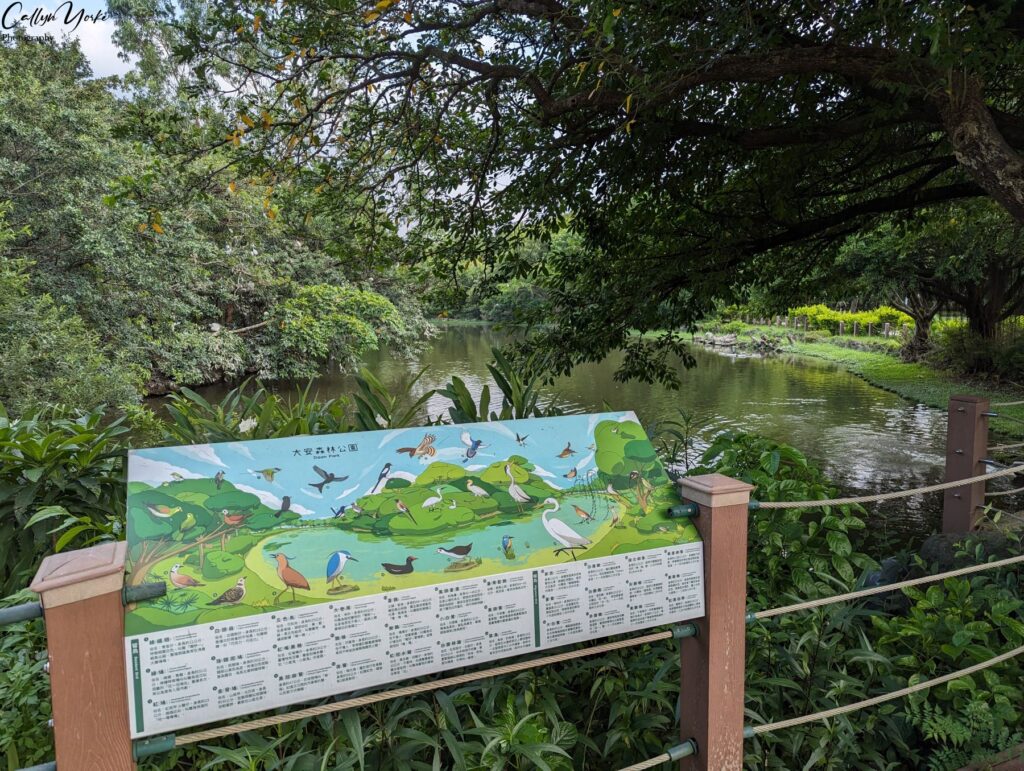
A large, artificial pond (‘Ecological Lake‘ – EL), located in the northwest section (see above map), supported an egret-heron colony in and around broad-leaved trees that formed an elongated, oval shaped, forested island. The water around the island, pumped in from an external source, provided habitat for turtles (Pseudemys spp.), carp, minnows (e.g., Cyprinidae) and Common Moorhen; pond margins and shallows attracted Black-crowned Night Heron and Little Egret. Interestingly, Cattle Egret, while nesting abundantly in the trees at this aquatic site, evidently preferred to forage elsewhere, e.g. in large, open grassy fields.
Park Recreational facilities included ball courts, exercise equipment and a roller-skating rink. Leashed dogs, radios and loud noises were permitted; bicycles and motor vehicles (except for maintenance) were prohibited in the park. Weekends, as expected, tended to be the most crowded times in the park; many birds apparently fled the park on those days.

Taipei Botanical Garden (TBG). Three surveys: July 11 (0700-1010 hrs. with Da Thao Le Nguyen), July 12 (0700-1000 hrs.), and July 14 (0642- 0950 hrs.).
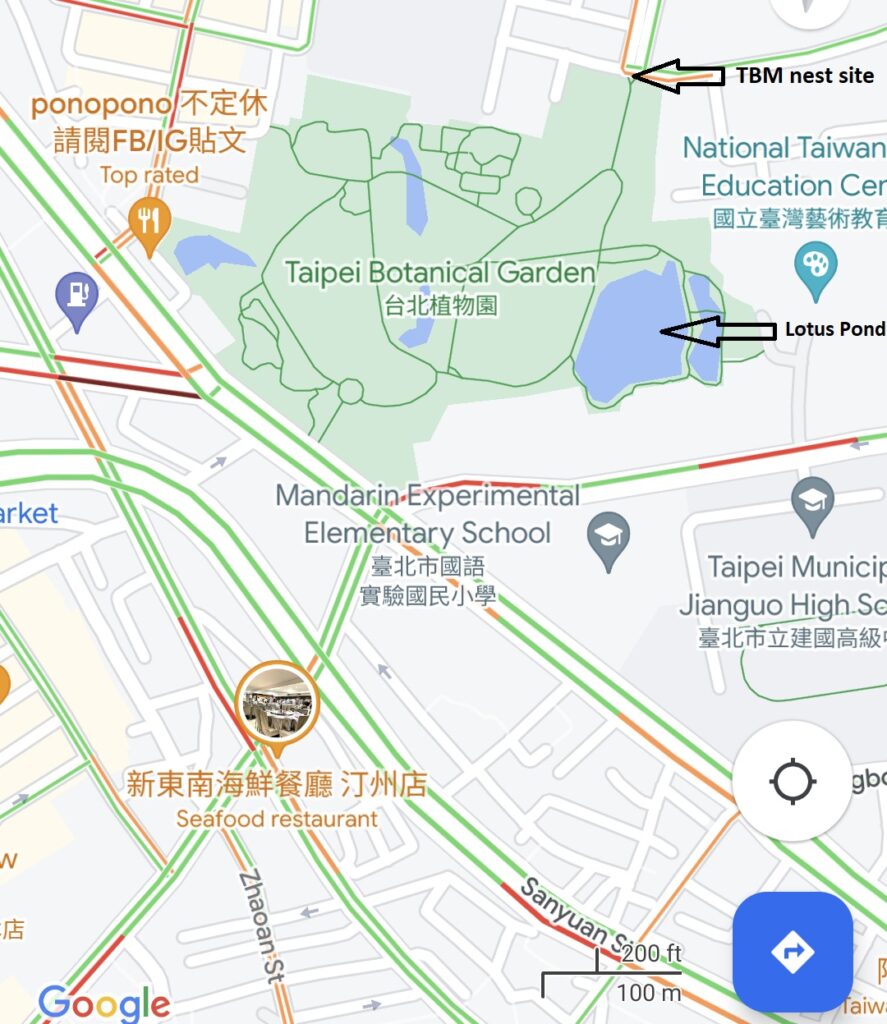
I walked variable routes throughout the botanical gardens, generally in a clockwise pattern, beginning and ending at the main, southwest gate entrance (free daily entry). Hundreds of people were in the gardens during my surveys, most of whom were engaged in an exercise routine of some sort, as in Da’an Forest Park. However, garden pathways were generally narrow, resulting in a multi-person traffic jam whenever I stopped to observe or photograph a bird. I tried to stay out of the way. Several photographers were at the Taiwan Blue Magpie nest site, just outside the northeast gate (see above map); Several more photographers frequented the Lotus Pond. One other birder was met briefly in the botanical gardens on July 14. Otherwise, I was about the only person visiting the gardens primarily for birding.
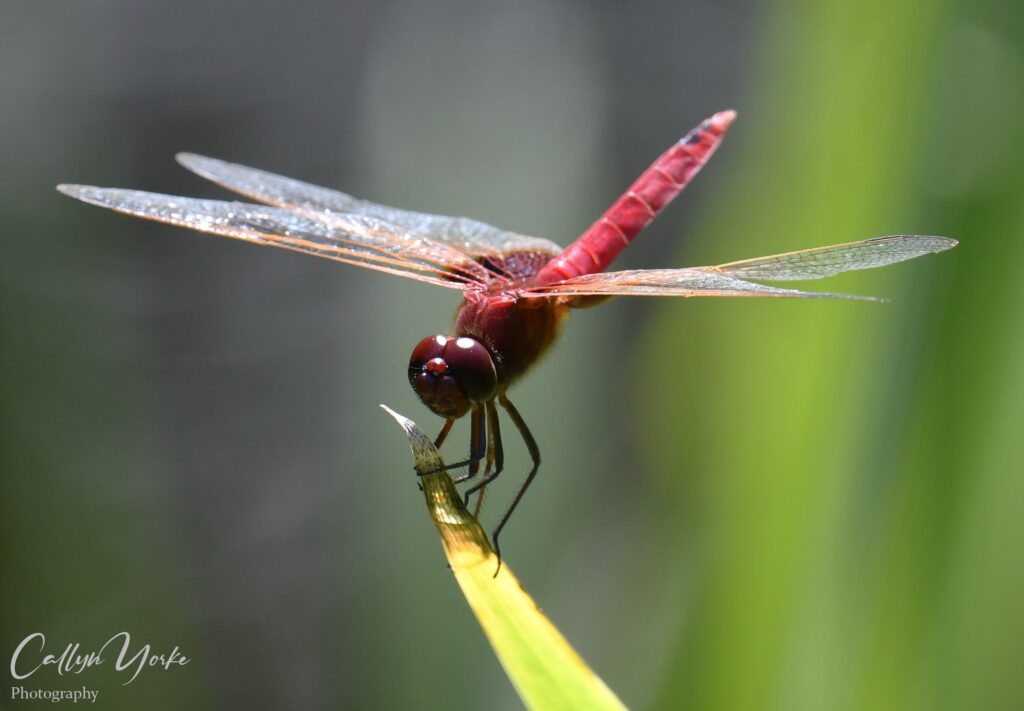
Habitats within the botanical garden were varied, as might be expected in a botanical garden featuring a large variety of plants from around the world. Most of the specimens and their respective taxonomic groups, were clearly identified with Latin binomials and plant-family designations. The property included a large pond (Lotus Pond), peripheral marsh, closed-canopy rainforest, eucalyptus woodland, and herbaceous gardens with many flowering and fruiting plants attracting butterflies and birds. In contrast with Da’an Forest Park, wooded areas in the botanical gardens had understory vegetation and multiple layers leaf-litter. Overall, the shady botanical gardens were kept in a comparatively natural state with minimum vegetation disturbance and removal.
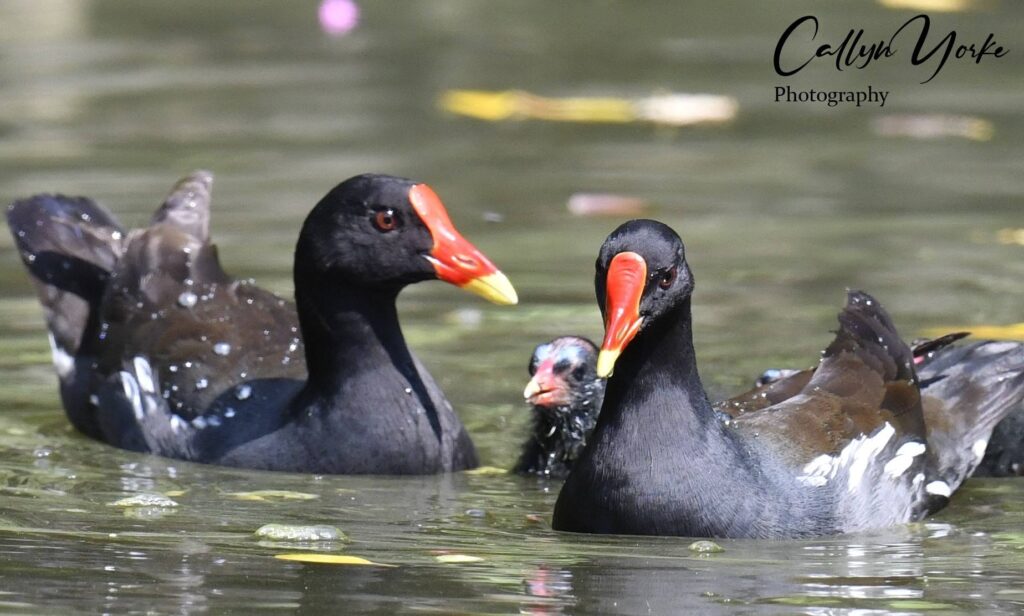
To a notable extent, the differences in vegetation and habitat management for TBG and DFP, were reflected by differences in the bird species observed in those two places. For example, although the land area of Taipei Botanical Garden is considerably less than that of Da’an Forest Park, TPG featured three endemic bird species I had not found in DFP, despite having completed twice as many surveys in the latter location, i.e. Taiwan Blue Magpie, Black-necklaced Scimitar-Babbler and Taiwan Scimitar-Babbler.
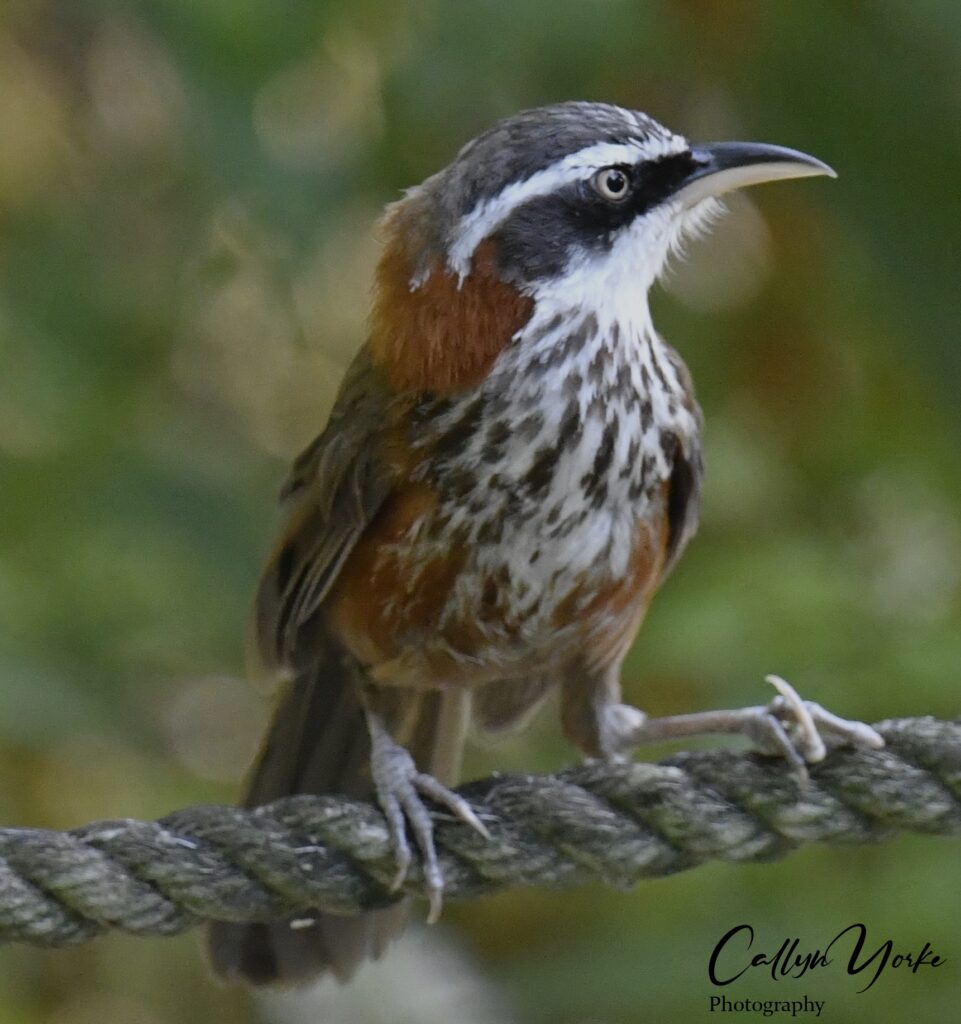
Huajiang IBA Wild Duck Park (HWD). One survey, July 15, 2023 (0642-0845 hrs.).
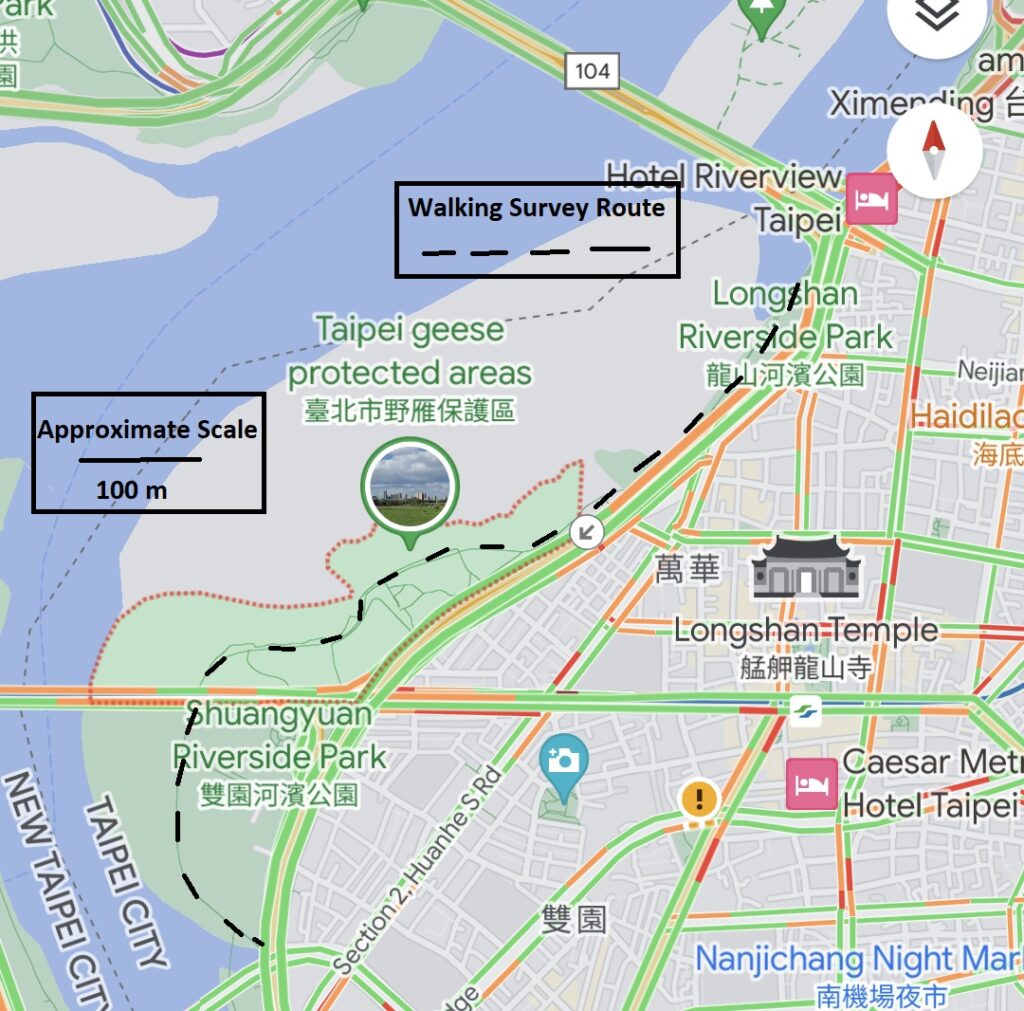
I made a walking survey of the southeast bank of the Tamsui River, beginning at the parking lot entrance to the Huajiang IBA (Important Bird Area) Wild Duck Park. Initially, I walked northeast along a paved path to the Zhongxing bridge, then reversed on the same path, heading southwest through HWD to the Wanban bridge. Habitats surveyed included riverside marsh-grass, tidal mudflats, open water, mowed fields with scattered fruiting trees and patches of riparian vegetation bordering the riverbank. Most of the park was closed for road construction. I proceeded through the park without any issues. Only one other couple with three unleashed dogs, crossed my path during the survey. Adjacent bike and motorways had moderately heavy traffic.
Guandu (GU); adjacent western section of the Danshui River Basin Wetland, located on the northeast bank of the Tamsui River. One survey: July 10 (0915-1010 hrs.).

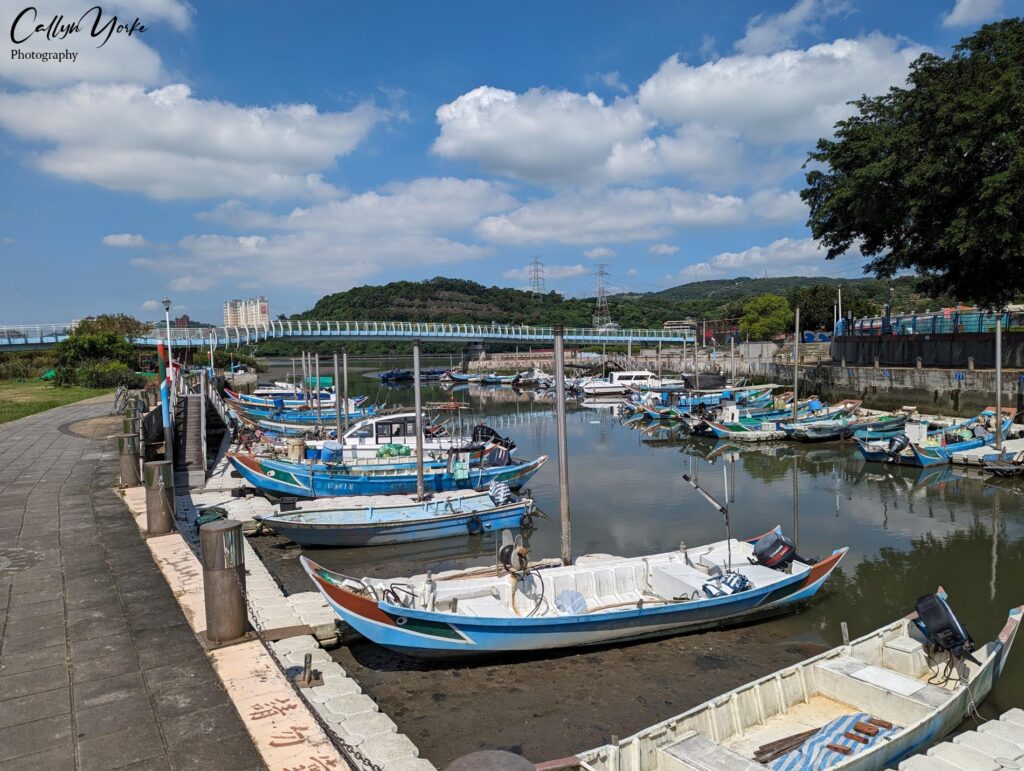
This was a comparatively brief, late-morning survey that I made on our return trip from Yangmingshan National Park. I walked on a paved pedestrian pathway overlooking the river basin wetland; distant mangrove and exposed tidal flats were visible from a pedestrian bridge adjacent to a canal harbor connecting with the Guandu Nature Park.
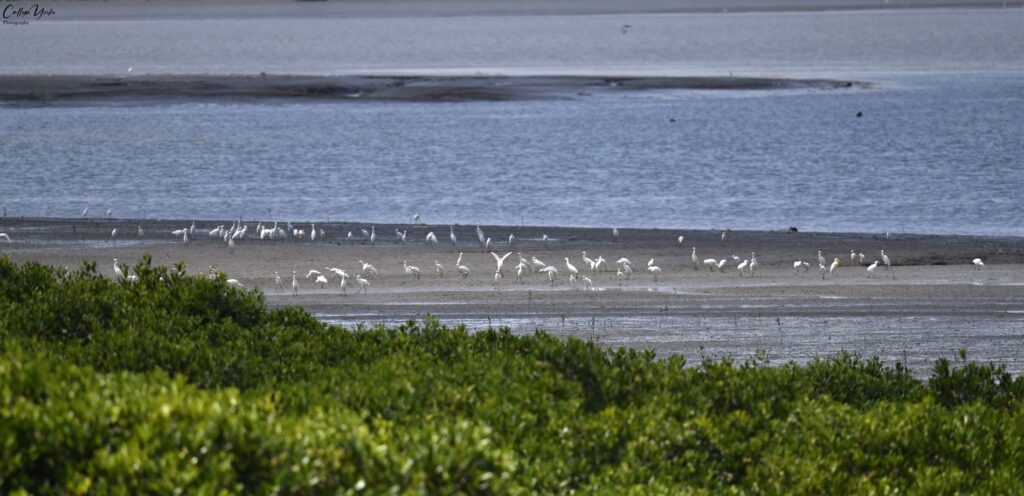
Here, a scope would have been useful; many egrets (at least three species) were gathered on the riverside mudflats about 500m to the south. Some of those birds commuted to and from a backwater marsh north of the roadway (see previous map above).
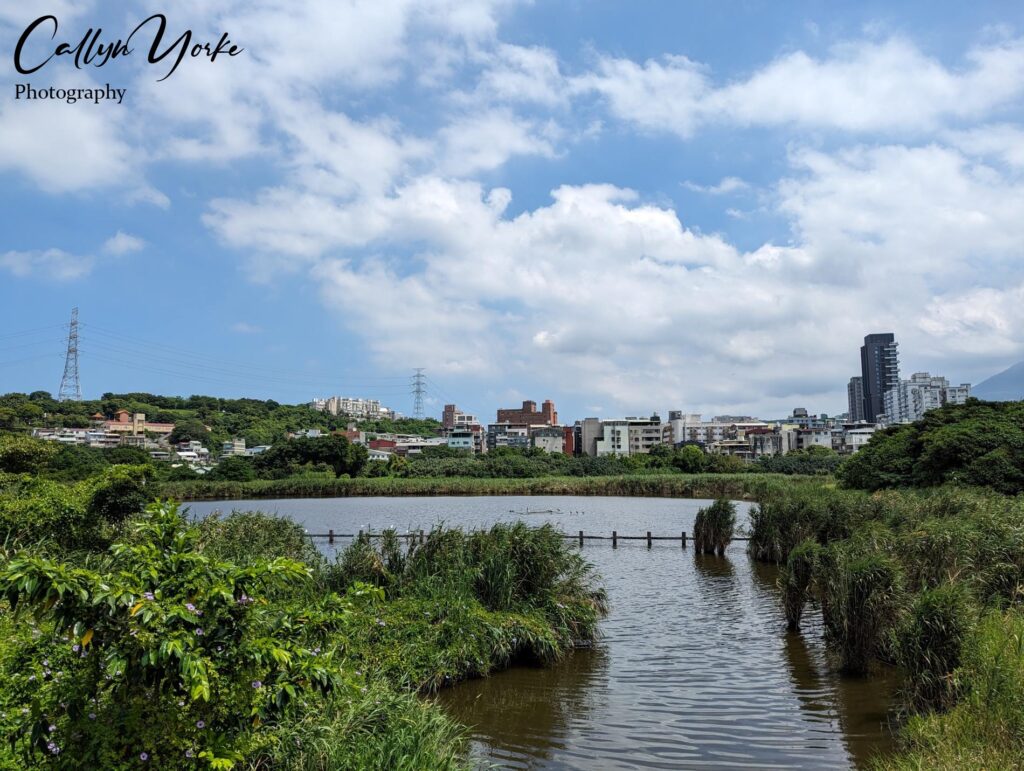
The mudflats adjacent to a pedestrian bridge and small harbor, supported a thriving population of mudskipper (Periophthalmus modestus). Although the habitat appeared appropriate for migratory waterbirds, e.g. perhaps a small number of non-breeding individuals, over-summering or the first cohorts of juveniles arriving from northern Asia, I found no small waders of any kind. That was actually not too surprising.
I expect that this area would support significant numbers of migratory shorebirds from about the middle of August through April. I was well aware that, at this latitude (25°N), July would be suboptimal for shorebirds; summer bird survey reports for the region were about as scarce as the peeps and plovers I had wished to see. In July, one would probably have to go about ten degrees further northward in latitude (1,126 km) to begin seeing a few of the early arriving shorebirds along the East Asian flyway.
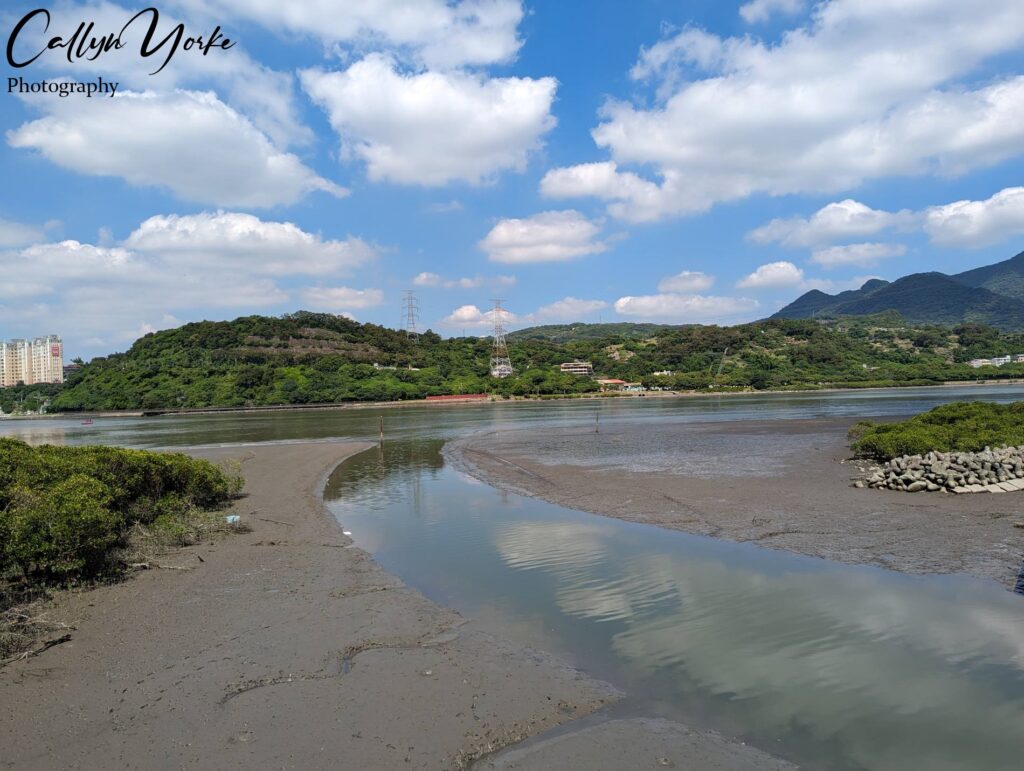
Yangmingshan National Park (YNP). One survey (July 10: 0640-0805 hrs. with Da Thao Le Nguyen).
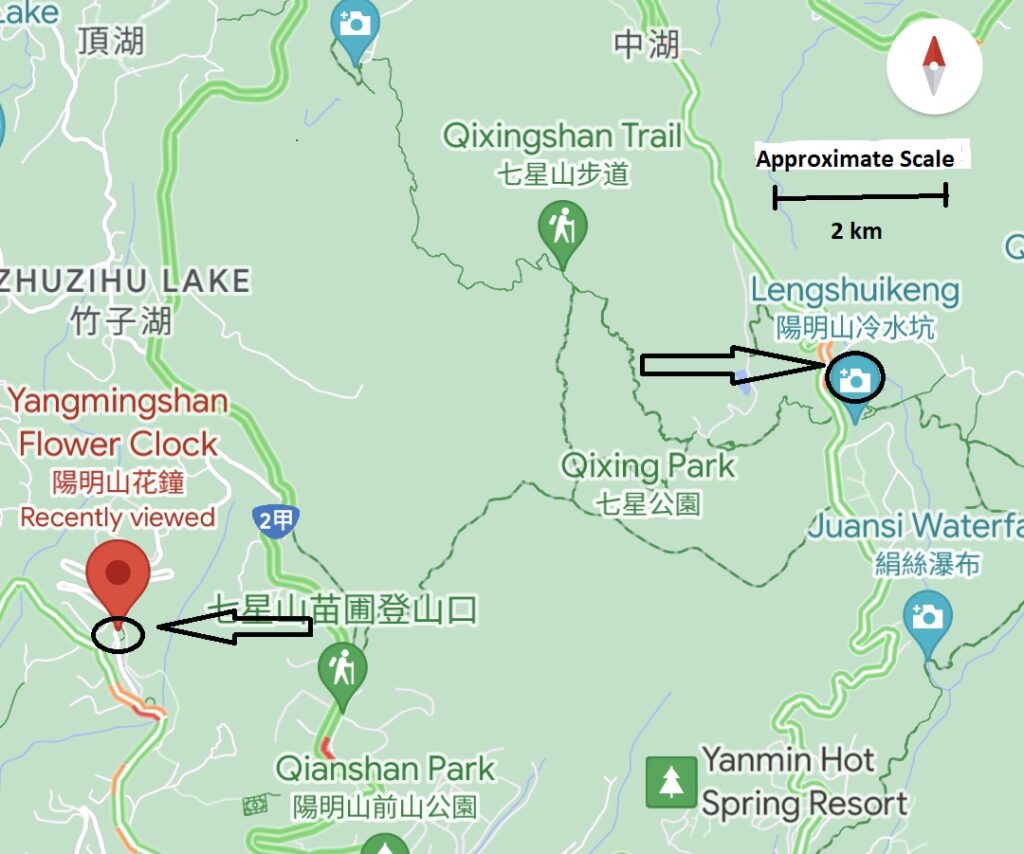
Two brief walking surveys were made in separate parts of YNP. Initially, our four-hour. private car hire ($US 43) took us directly to the Lengshuikeng visitor center and trail head (Elevation 745 m). Thao and I walked eastward on the hiking trail, first stopping at an elevated platform overlooking a sulfur springs pond that produced a pungent sulfur odor throughout the area. We continued across a pedestrian suspension bridge, turned southward and soon arrived at an ‘Ecological Pool.’ No birds were heard or seen there. We reversed from that point and returned to the visitor’s center parking area.
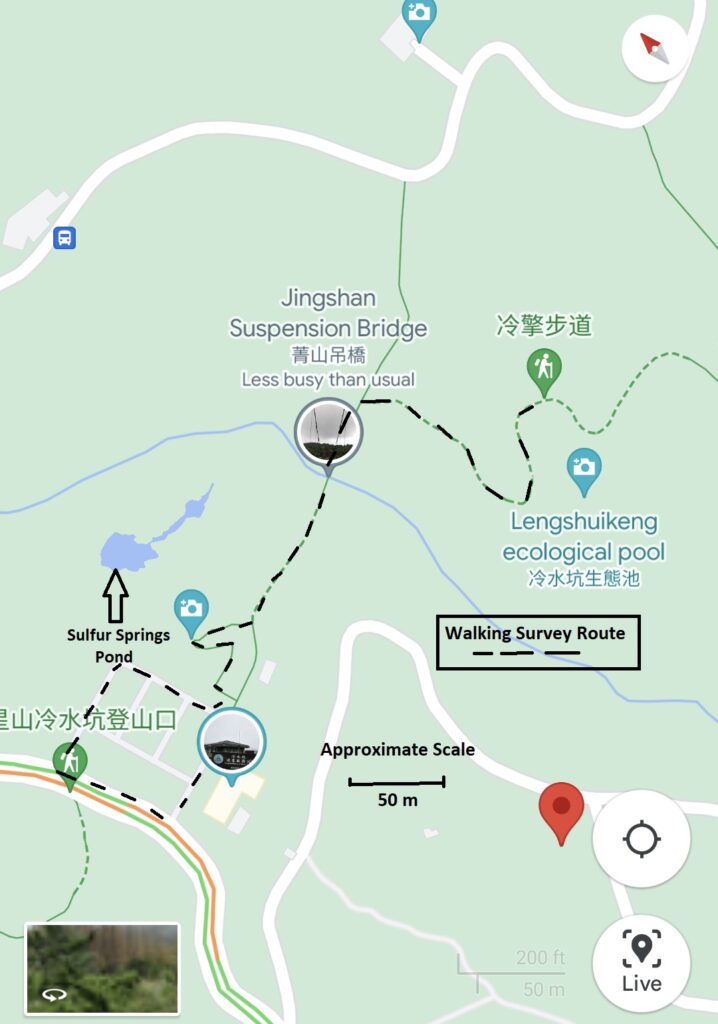
Except for a brief glimpse of a Lesser Coucal in flight (new for the trip list) and a pair of Light-vented Bulbul, birdlife in this mountain wilderness was all but absent. We returned, motoring down the winding roadways to the Flower Clock Garden area (Elevation 425 m). There, we made a brief walking survey through the gardens adjacent to the main parking area. Again, birds were few and far between, e.g. Gray Treepie and the ubiquitous Swinhoe’s White-eye. It appeared our money would have been better spent visiting other natural areas, perhaps south of Taipei.
National Chengchi University, Taipei (NCU). One survey: July 13 (0630-1030 hrs.).

I began a walking survey at the main entrance of the university campus, passing through a courtyard ringed with fruiting trees and full of birds. In fact, this was one of the birdiest places I had seen in Taipei. Some really cool bird species were found on the campus, including a nesting Black-naped Monarch and several small flocks of Black Drongo, both new for the trip list.
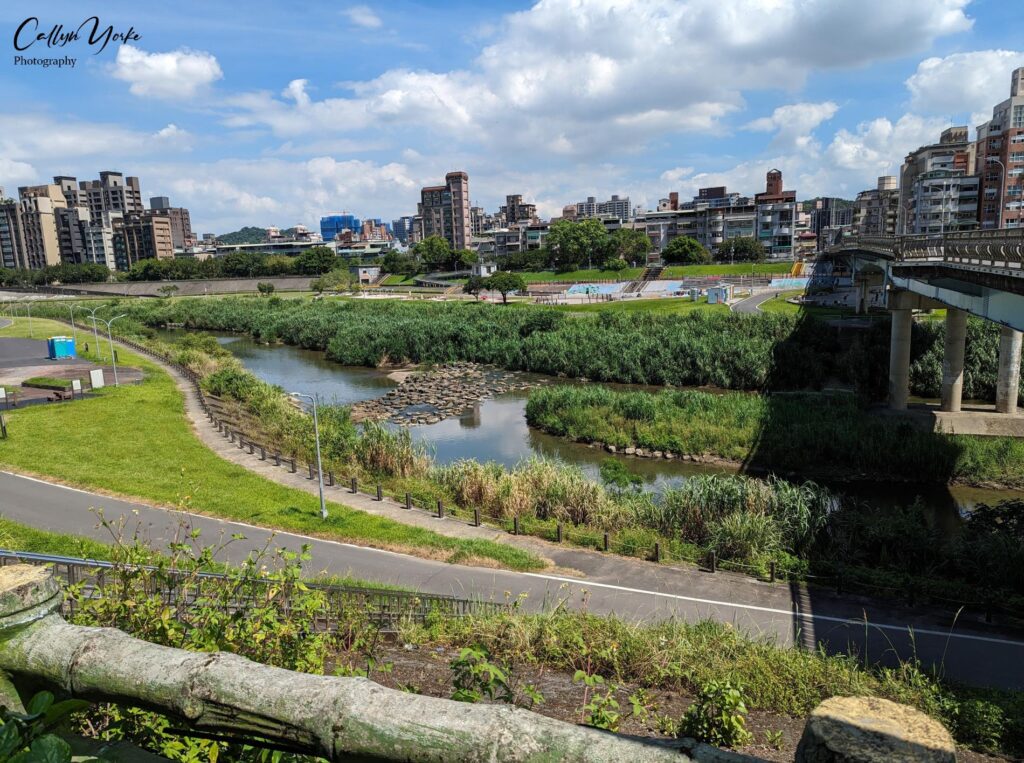
I followed a paved pedestrian path, overlooking a small stream, and turned south on Mountain Circle Road, leading into the adjacent, forested hills adjacent to the university dormitories. Interesting signage was along the roadside.
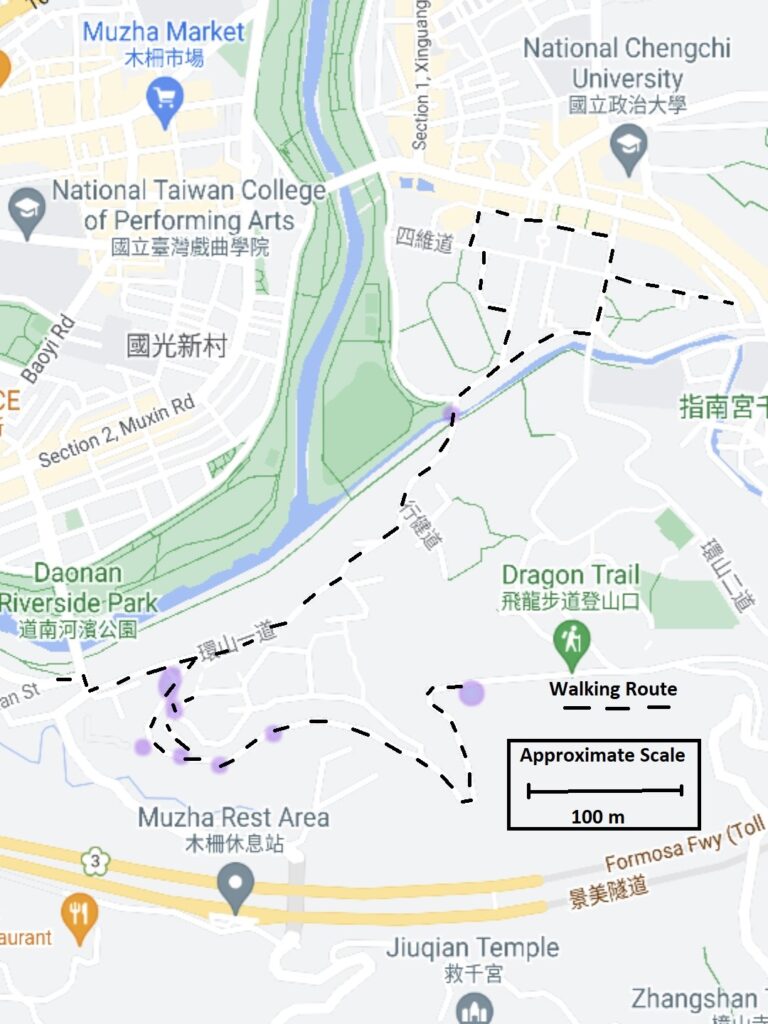
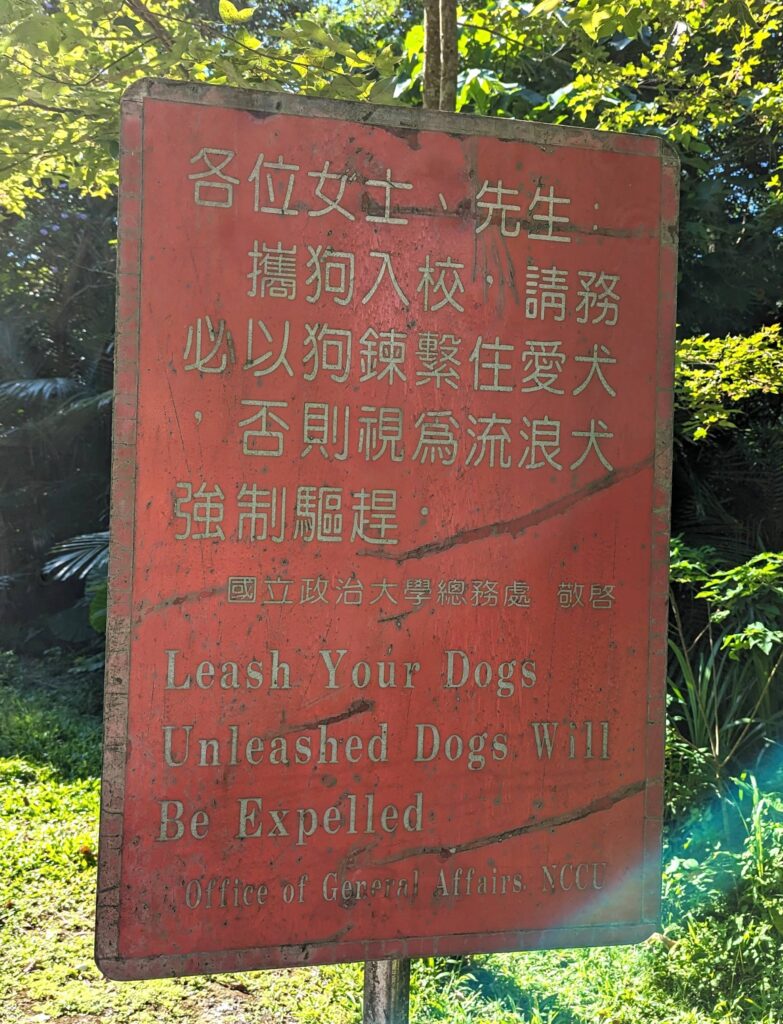
Some of the best preserved tracts of broad-leaved deciduous forest in Taipei were in the foothills of the National Chengchi University campus. I guess the surrounding hill forest must have been a scary place, since I was evidently the only one hiking through the area — definitely a memorable experience in Greater Taipei, a metropolitan area of about seven million.

It was a mostly clear, sunny day and I was feeling the effects of a steady, uphill pace, sweating through the neck straps of my binocular and camera. I paused for a rest on a shaded bench next to the RIIC building (Research and Innovation Incubation Center). The altimeter on my wrist watch read, 135m. This seemed like an appropriate spot for hatching some concluding thoughts, as we were approaching the end of our Taiwan visit.

I couldn’t get the roadway signage out of my mind. Were students really paying attention to the warnings? I’m sure they already had plenty other problems to worry about, e.g. grades, finances, broken hearts. Anyone who has been to college, or worked in a fast-food restaurant (some folks are in both those categories), knows something about stress. It can be intense. In California State Universities, for instance, a 50% drop-out rate after the first year is about average. Successfully dealing with stress might be the most valued lesson learned from higher education. No wonder there are so many tearful smiles on graduation day. Those kids (and their parents) just survived a train wreck.
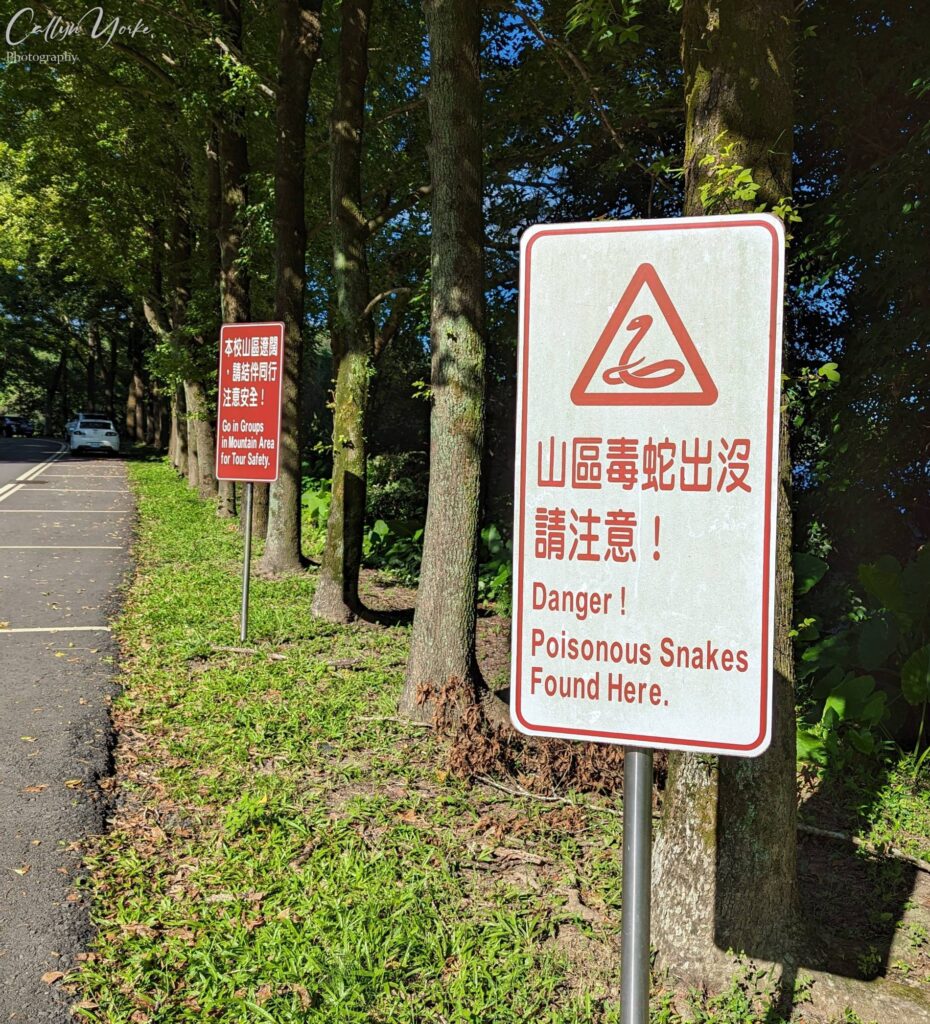
I could imagine a NCU student having a really bad day, telling his counselor on Monday that, in addition to being flat broke, 1) He failed his midterm English exam. 2) His dog got loose, was captured by the authorities and expelled from the university. 3) His girlfriend, while studying for a Biology exam in a quiet place outdoors, was bitten by a Taiwan Cobra and taken to the hospital.
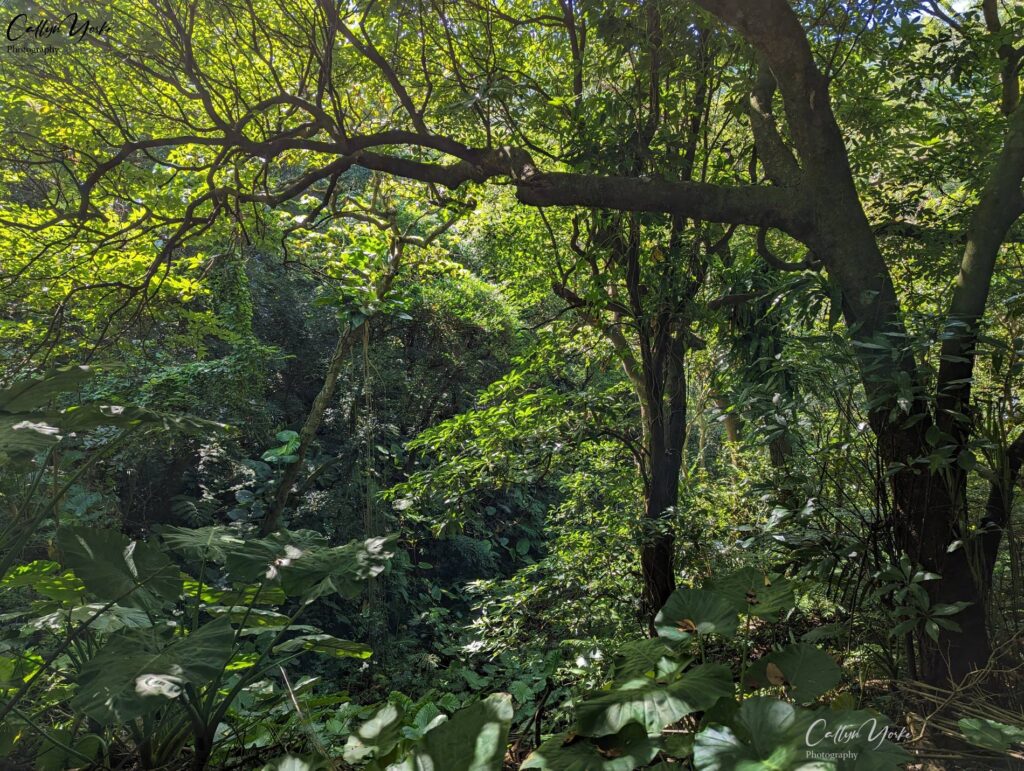
A NCU counselor might recommend the usual city park stress releasors — “Go for a run, bike ride, or join a yoga class ” — perhaps even, “Take a hike and find a new bird.”
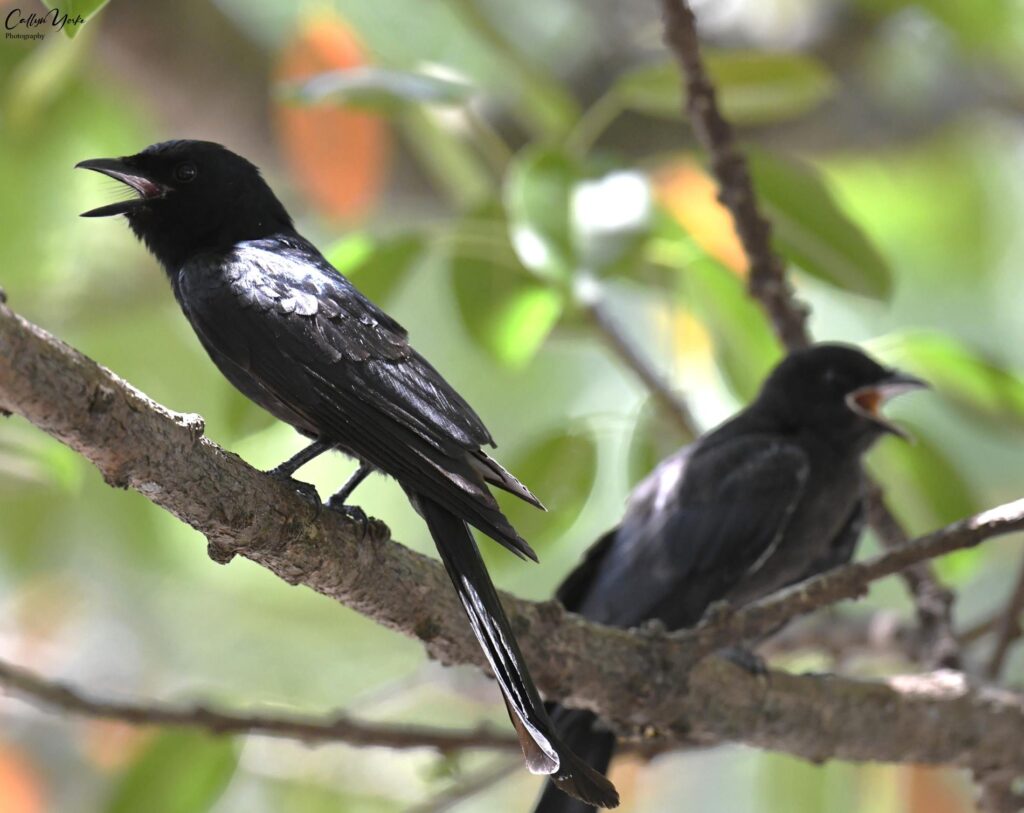
Although it may be an unconventional form of psychotherapy, every birder knows there is no better cure for the blues than finding a life bird. Anyway, a wide range of problem solving behaviors appeared acceptable in Taipei city parks, particularly DFP. If one ever needed to cut it loose in Taipei, the city park was the place to go. A foreign birder could almost blend in there. Well, not quite. Locals in the parks gave me looks ranging from friendly smiles, to mild suspicion, to total disregard. If not for stress relief, why else would I be there, dutifully making entries in a pocket notebook? Scouting a location for the film sequel to, “One Flew Over the Cuckoo’s Nest?”
They may have been right. Taiwanese are keen and careful observers. I suppose they must be pretty sharp to catch all the Chinese characters stacked up on freeway signs. But whatever were the Taiwanese opinions of me, I didn’t really mind. Because, today, at NCU, I was in cheerful spirits. I had just discovered my seventh life bird, a magnificent pair of White-bellied Green Pigeon. Yes! And that would be the Taipei life-bird grand finale. Xie Xie, Taiwan.
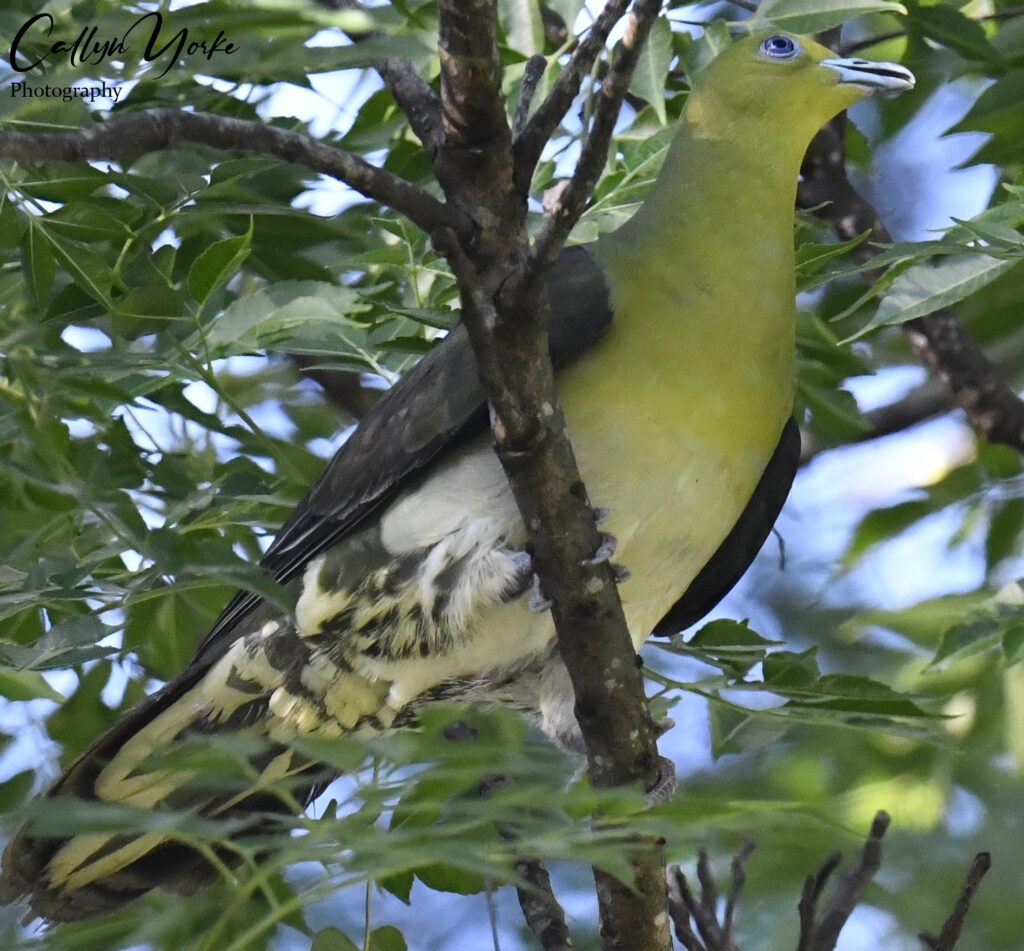
ANNOTATED BIRD LIST, Taipei, Taiwan July 8-16, 2023 Callyn Yorke
Abundance: Numbers following each species entry are the highest count for a single survey; Age, sex and molt (when known): ad = adult; imm = immature; m = male; f = female; bsc plmg = basic (non-breeding plumage; alt plmg = alternate (breeding) plumage.
Frequency and Distribution (C, UC in reference to areas receiving multiple surveys) : C = Common, i.e. found during half or more of the surveys ; UC = found in less than half of the surveys; ubiq. = ubiquitous in appropriate habitat.
Survey Locations: DFP = Da’an Forest Park; TBG = Taipei Botanical Garden; HWD = Huajiang Wild Duck Park; GU = Guandu-Danshui River Basin Wetlands; YNP = Yangmingshan National Park; NCU = National Chengchi University.
Ecology and Behavior: aerial insect hawking (ah); taking fruit, berries or parts of flowers (fr); gleaning insects from foliage (ig); probing into surface (pr); estimated height (m) above ground (agl); gregarious (greg); mixed-species flock (msf).
Systematics and Nomenclature used herein, is an amalgam of Avibase, International Ornithological Congress (IOC) and current (2023) online resources, i.e. Birds of the World, Cornell University, USA.
Taiwan endemics are listed in Bold Face lettering.
- Eastern Spot-billed Duck Anas zonorhyncha 2 a pair swimming in riverside shallows, HWD.
- Feral Rock Pigeon Columba livia (exotic) 120 greg., often in msf foraging on ground, lawns and pavement; roosting on overpass beams and on tall buildings, ubiq., C
- Ashy Wood Pigeon Columba pulchricollis 2 observed in fast flight over tree canopy, TBG, UC.
- Oriental Turtle-Dove Streptopelia orientalis 8 greg. vocal in trees, foraging in msf on lawns and ground, ubiq. C.
- Red-collared Dove Streptopelia tranquebarica 1 (imm.) on ground near a small group of trees, UC, DFP.
- Eastern Spotted Dove Spilopelia chinensis 2 HWD, NCU.
- White-bellied Green Pigeon Treron sieboldii 2 a pair foraging in the canopy of a fruiting tree, NCU.
- Lesser Coucal Centropus bengalensis 1 vocal prior to a short flight over open, grassy area around sulfur spring pond, YNP.
- House Swift Apus nipalensis 1 flying low over and dipping into Lotus Pond with Barn Swallows, TBG, UC.
- Eurasian Moorhen Gallinula chloropus 5 (ad., imm) greg., adult pair and young walking on edge of small, wooded island; adults occasionally swimming together in Lotus Pond, one making shallow dives for vegetation to feed young; hatchlings staying with adults, sometimes wandering a few meters away and climbing onto floating lotus leaves, TBG, DFP, C.
- White-breasted Waterhen Amaurornis phoenicurus 3 (ad, imm) rather shy and usually near cover; individuals and pairs with young, foraging while walking in wet areas near ponds and riverside mudflats, DFP, HWD.
- Eastern Great Egret Ardea modesta 2 standing at the edge of the lake, and at the top of a tree in the egret-heron colony; not observed foraging, EL-DFP, UC.
- Intermediate Egret Egretta intermedia 20 (ad, imm) loosely greg., individuals foraging in grassy fields with Cattle Egret; in egret-heron colony trees and on mudflats with Little Egret, DFP, GU, C (photo).
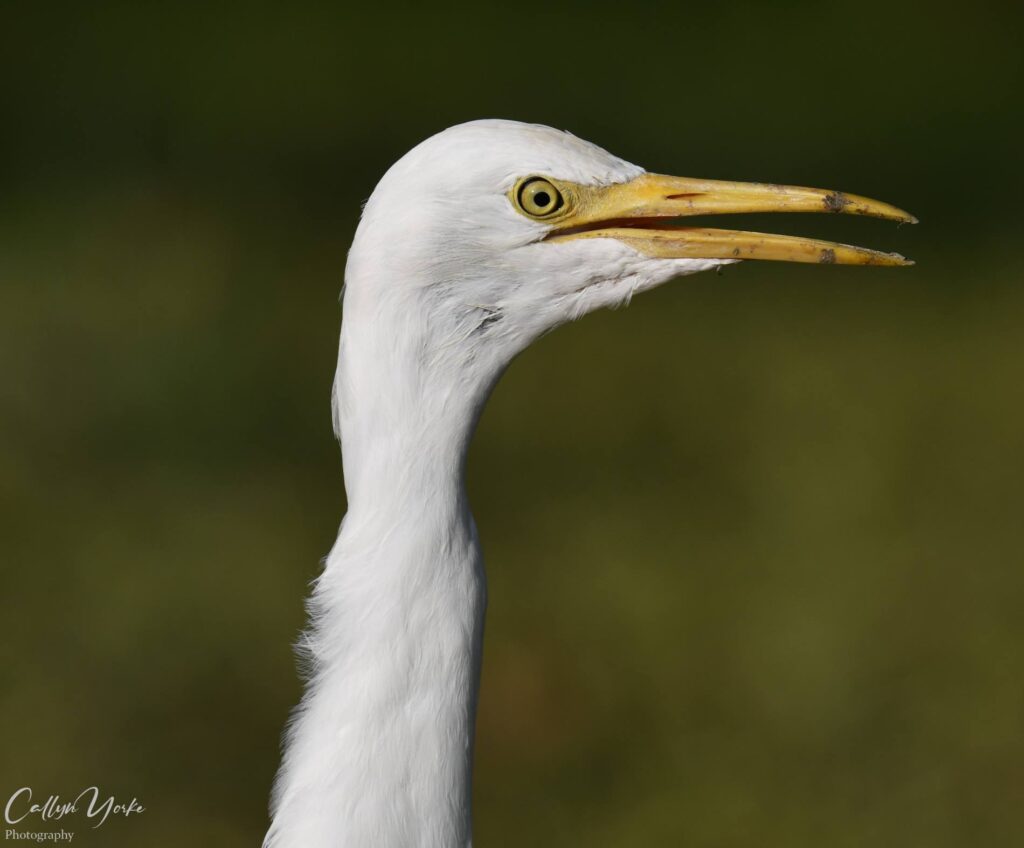
- Little Egret Egretta garzetta 120 (rough estimate from EL-DFP colony), (ad, imm) greg. some in various breeding stages (early to late nesting, incubation & fledging) in EL egret-heron colony; on mudflats and sometimes in wet fields, ubiq. C (photo).
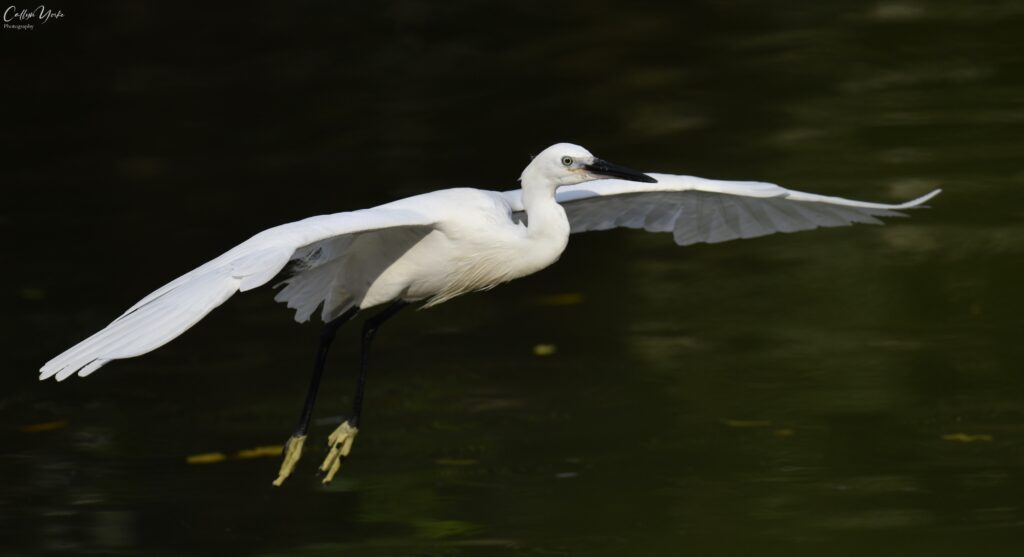
- Eastern Cattle Egret Bulbucus coromandus 250 (rough estimate from EL-DFP colony), (ad, imm); many in various breeding stages (early to late nesting, incubation and fledging), siblings in nest occasionally seen in combat; small flocks of adults in alt. plmg. foraging in open, grassy areas, commuting to and from parks at sunrise and sunset, ubiq. C (photo).
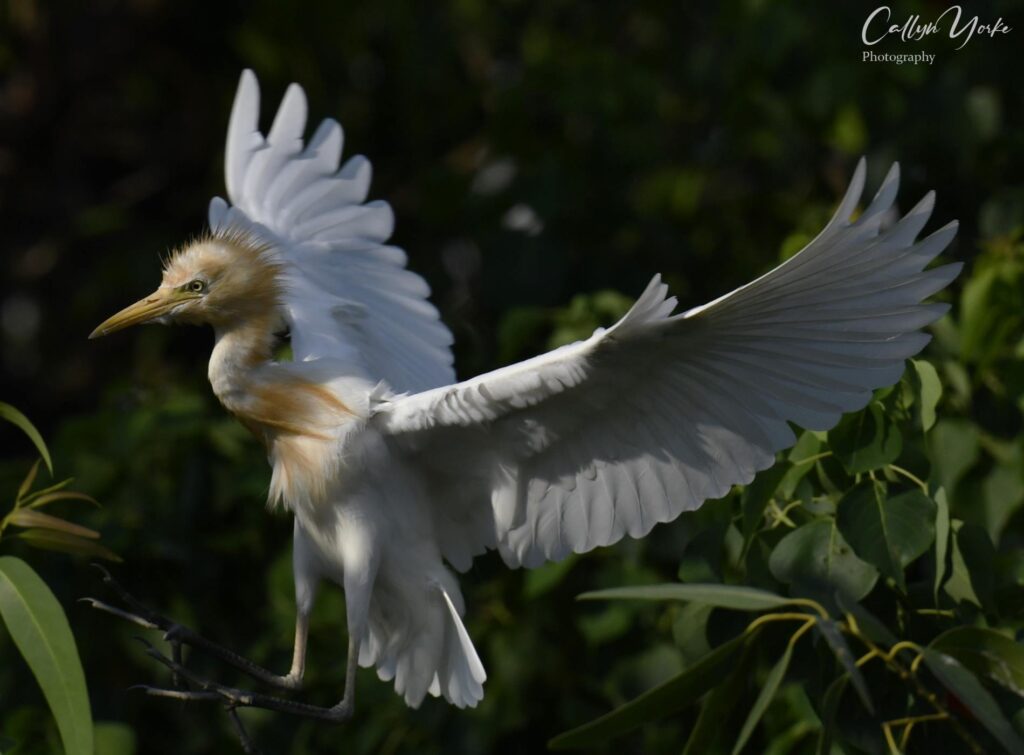
- Black-crowned Night-Heron Nycticorax nycticorax 60 (ad, imm) loosely greg., individuals and small flocks in shallows, on mudflats, flying to and from parks; none observed nesting, though abundant in and around EL-DFP egret-heron colony, ubiq, C (photo).

- Malayan Night-Heron Gorsachius melanolophus 8 (ad, imm), individuals foraging diurnally in wet, grassy areas at edge of woodland and ponds, sometimes in clearings; comparatively tame and approachable; immatures seen taking small arthropods. Nesting not observed. One young adult (3rd. yr?) in DFP with tarsal bands (W,G;Al #6097?,W) – see remarks in Introduction with close-up photo of tarsal bands; photo below). Predominantly first and second-year birds seen in DFP, where this species was common (C); single bird sightings in TBG and NCU.
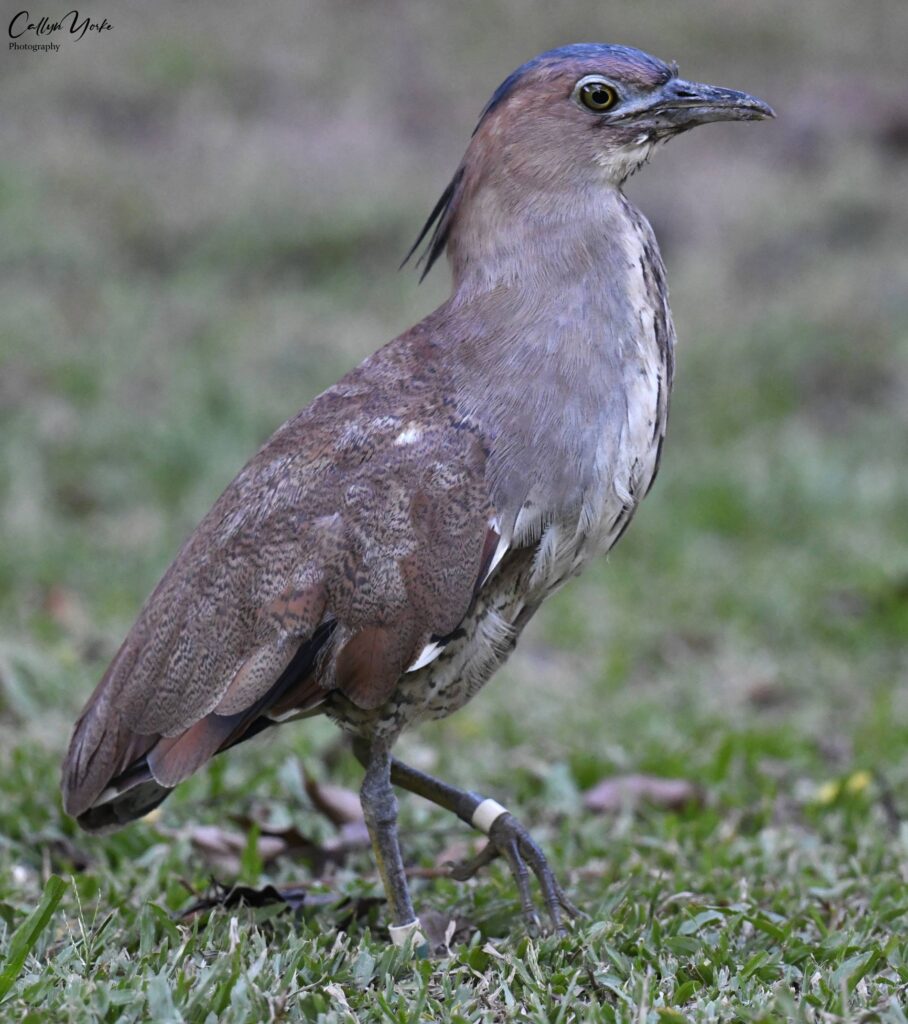
- Oriental Honey Buzzard Pernis Ptilorhynchus 1 flying 100m overhead, UC TBG.
- Crested Goshawk Accipiter trivirgatus 2 (ad, imm) in subcanopy of mature trees, often mobbed and scolded by other birds, e.g. Light-vented Bulbul, UC TBG, DFP.
- Common Kingfisher Alcedo atthis 1 flying low over Lotus Pond, UC, TBG.
- Taiwan Barbet Psilopogon nuchalis 15 (m,f; ad, imm) vocal and usually well concealed in canopy of mature broad-leaved trees; DFG -an active nest cavity in a dead tree with two cavity holes about 3m agl, one occupied by nestling (s) and periodically (perhaps every 30 minutes) revisited by adults. One adult seen exiting nest cavity with fecal material in beak. Several photographers set up with tripod gear around the nest cavity tree. Elsewhere, I found a several individual barbets consuming small fruits from a mature broad-leaved tree (DFP – July 9) and another attempting to consume a large praying mantis on the afternoon of July 12 in DFP (see photo and additional notes on this species in the Introduction); C, ubiq. (photo).
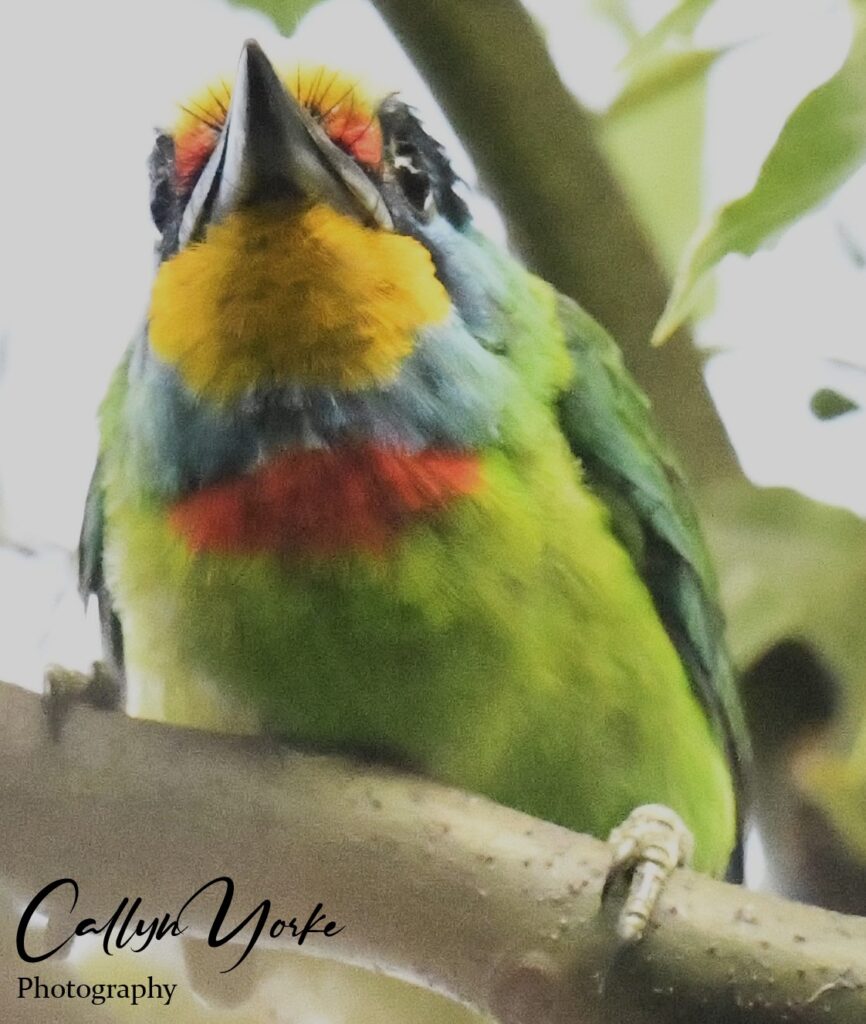
- Black Drongo Dicrurus macrocercus 10 (ad, imm) several small flocks of adults and immatures, suggesting family cohorts, ah from low to mid-level trees at edge of clearings, NCU.
- Black-naped Monarch Hypothymis azurea 2 (m,f) individuals sallying in forest, through dense, vine tangled understory at mid-level; one female alighting next to a nest (see photo in previous section), NCU.
- Taiwan Blue Magpie Urocissa caerulea 2 (m,f) individual birds keeping apart mostly on and around nest in subcanopy of small, broad-leaved tree near gated entrance (see map in previous section); in addition to spending several minutes sitting on the nest of sticks, two adult birds were making short flights around the immediate area, alighting in trees and a roof-top (once), apparently, circling the nest site. The contents of the nest could not be determined when viewing from the street level. Several photographers, including myself, were present below the nest tree on two successive days, C TBG (photo).
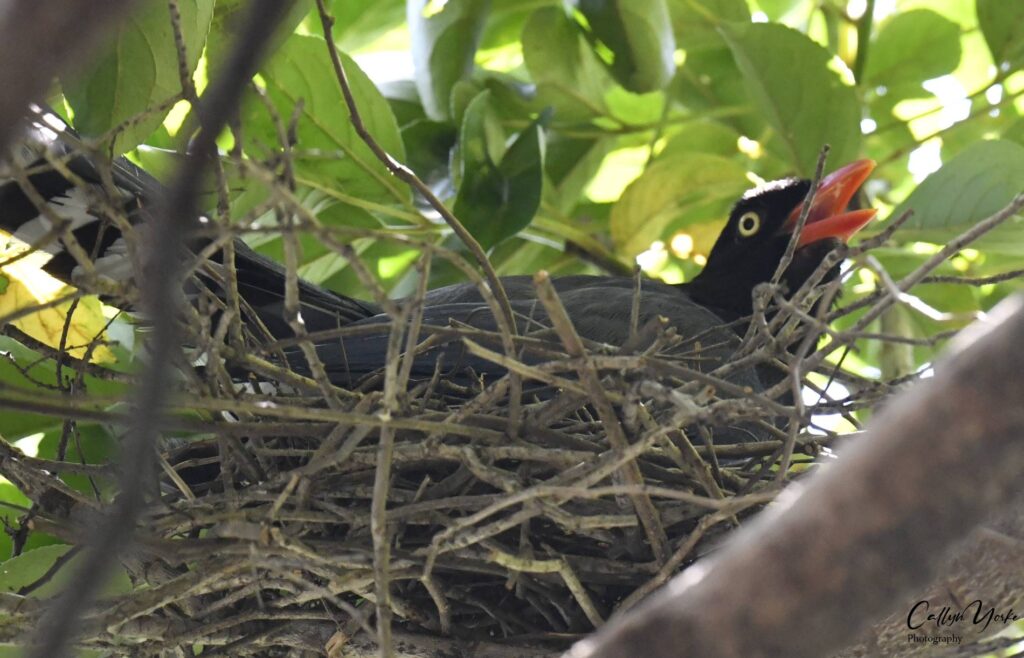
- Gray Treepie Dendrocitta formosae 10 vocal (most commonly, softly issued contact calls), greg., perched in subcanopy and mid-level at forest and woodland edges, orchards, gardens, mangrove. Sometimes moving much higher into tree canopies, e.g. 25m agl; these birds consistently preferred shade during hot weather, thermoregulating by buccal evaporation (mouth agape), as for most (but not all) bird species found in this region, when the ambient air temperature reaches about 32°C; NCU, GU, HWD, YNP.
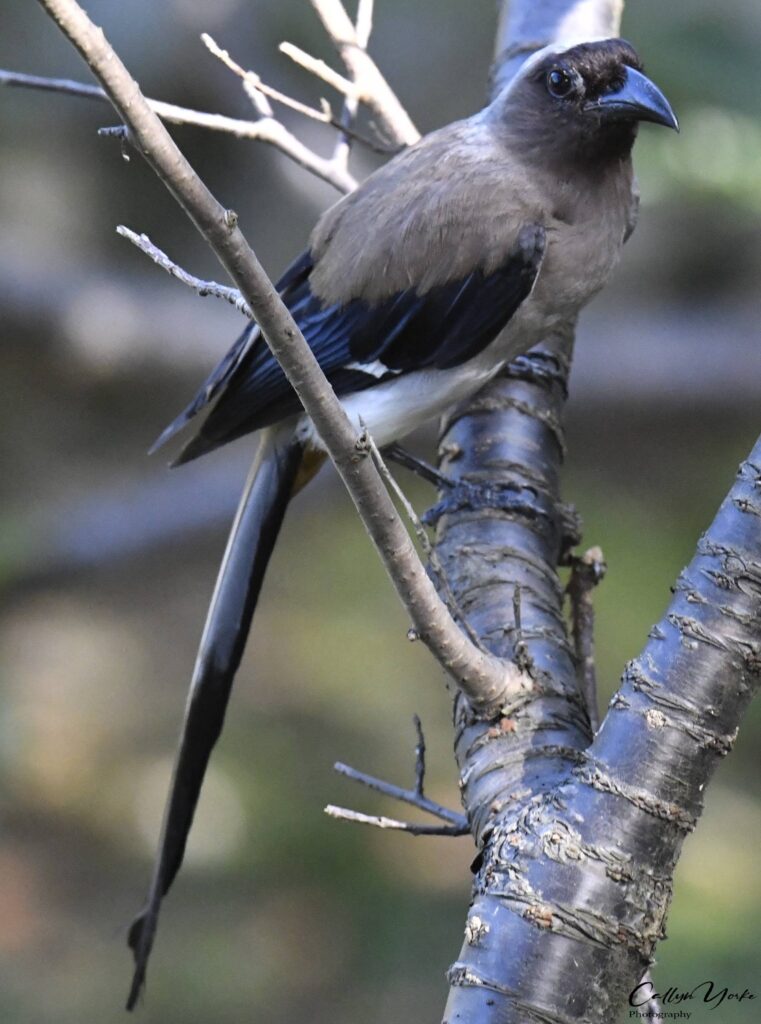
- Oriental Magpie Pica serica 2 (trans. bsc. plmg.) greg. vocal vigilant pairs in trees and foraging on the ground in adjacent grassy fields; C, DFP, HWD (photo).
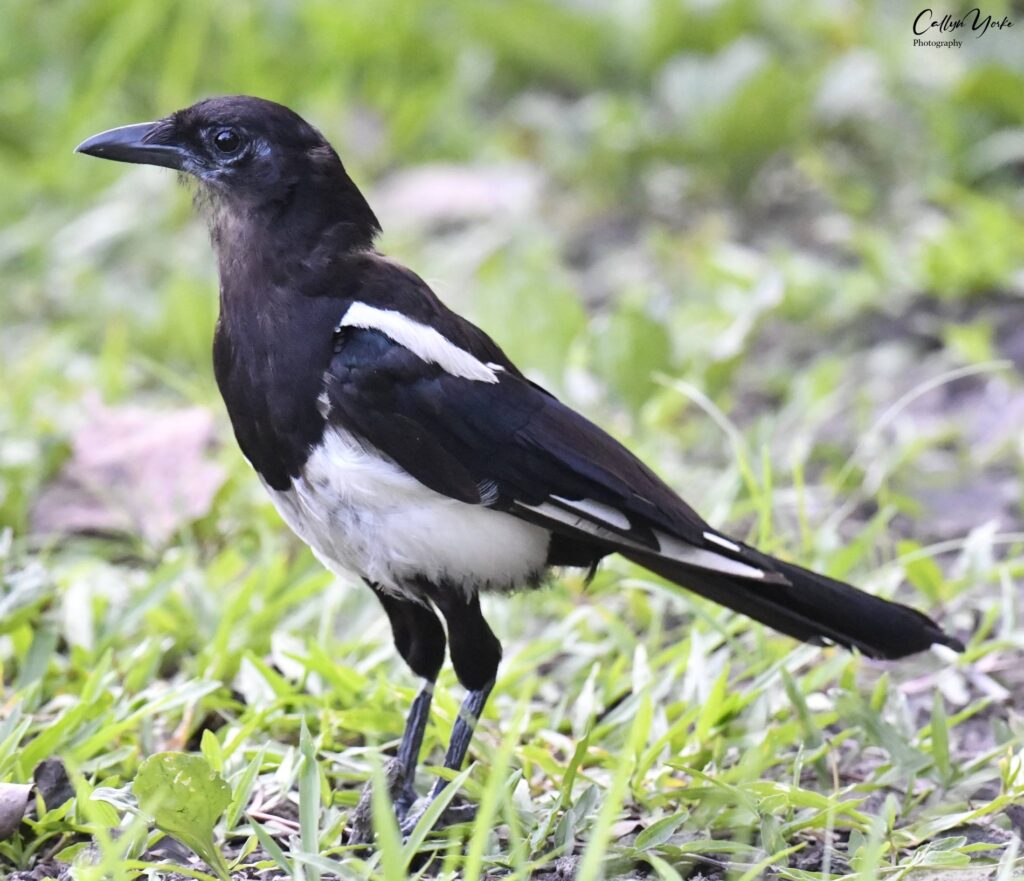
- Plain Prinia Prinia inornata 2 vocal (song) in second-growth shrubs on the riverbank adjacent to a grassy field, HWD.
- Barn Swallow Hirundo rustica 8 greg. flying back and forth, low over ponds, often dipping into the surface for a drink; adult staying near nest with young under an overpass above the Da’an Park District jade market, Taipei C, TBG, DFG, GU (photo).
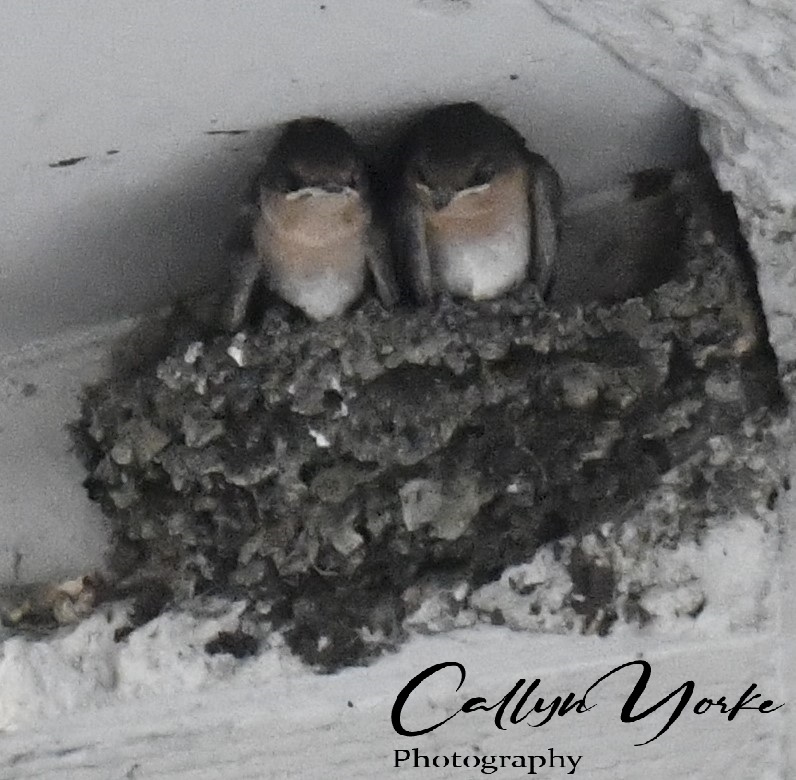
- Pacific Swallow Hirundo javanica 1 individuals loosely and briefly associated with Barn Swallow, seen only twice flying over EL- DFP, UC.
- Light-vented Bulbul Pycnonotus sinensis 25 (ad, imm) vocal, greg. small flocks, e.g. family cohorts, foraging at all levels, ground to high tree canopies; sometimes found mobbing and scolding Crested Goshawk in woodland subcanopy, C, ubiq..
- Black Bulbul Hypsipetes leucocephalus concolor 10 (ad., imm) vocal, greg. highly active and mobile in msf with LVBU, 4-10 birds in canopies of fruiting figs and other trees, C, ubiq.
- Swinhoe’s White-eye Zosterops simplex 20 vocal, greg. flocks of 5- 10 individuals foraging in foliage of a large variety of shrubs and trees, C, ubiq.

- Taiwan Scimitar-Babbler Pomatorhinus musicus 1 (ad) fairly shy, perched low and moving about quickly in gardens and in upper mid-level of shady patch of broad-leaved forest, C, TBG.
- Black-necklaced Scimitar-Babbler Erythrogenys erythrocnemis 1 shy and retiring, vocal (song and calls) in understory of forest, UC, TBG.
- Asian Glossy Starling Aplonis panayensis 10 greg. seen twice in flight over open urban areas with scattered ornamental trees, and on rooftop of the Taipei National Theater, UC, HWD, TBG.
- Black-collared Starling Gracupica nigricollis 3 (ad, imm) vocal, greg. adults attending young on ground in shade; commuting between adjacent buildings and the park C, DFP.
- Common Myna Acridotheres tristis (exotic) 12 vocal, greg. locally numerous foraging on ground and in grassy fields with conspecifics or in msf with Javan Myna; C, HWD, NCU; UC– DFP (photo).
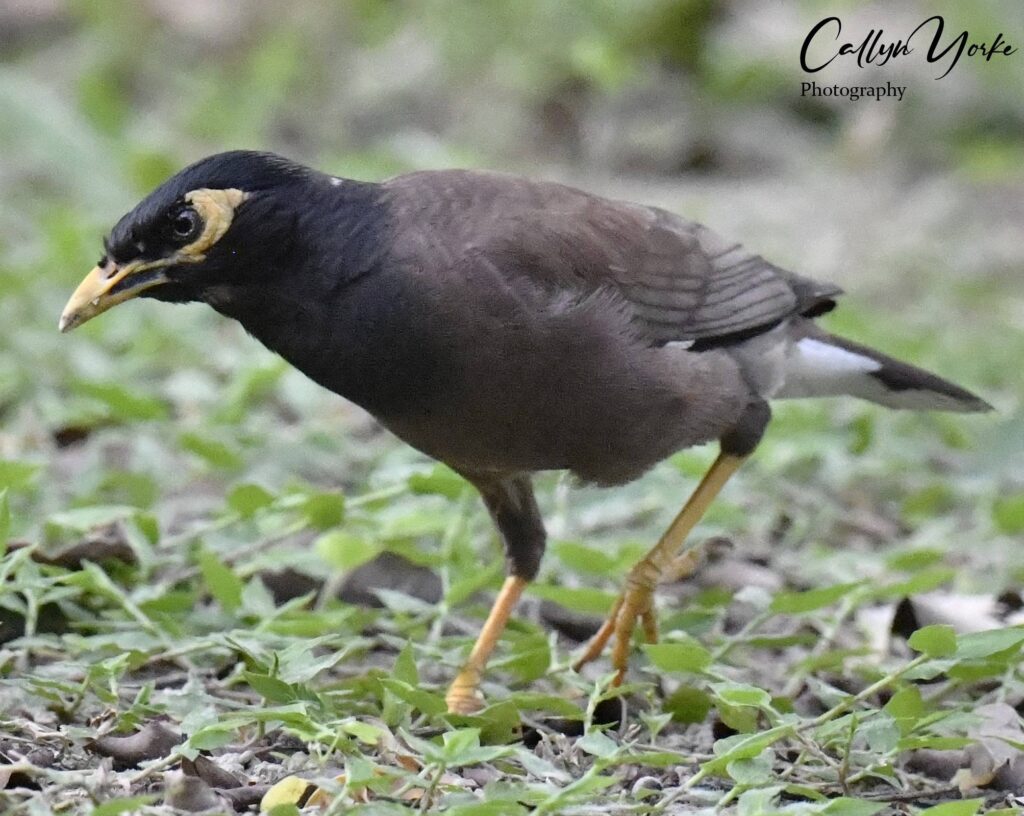
- Javan Myna Acridotheres javanicus (exotic) 10 (ad, imm) vocal, greg. foraging on ground in a wide variety of disturbed and undisturbed, terrestrial and aquatic habitats; often in msf with Common Myna and Crested Myna (HWD); C, DFP (photo), NCU, GU, HWD.

- Crested Myna Acridotheres cristatellus 2 (trans. bsc. plmg.) greg. a pair foraging on in shaded, weedy areas in msf with Javan Myna, HWD (photo).
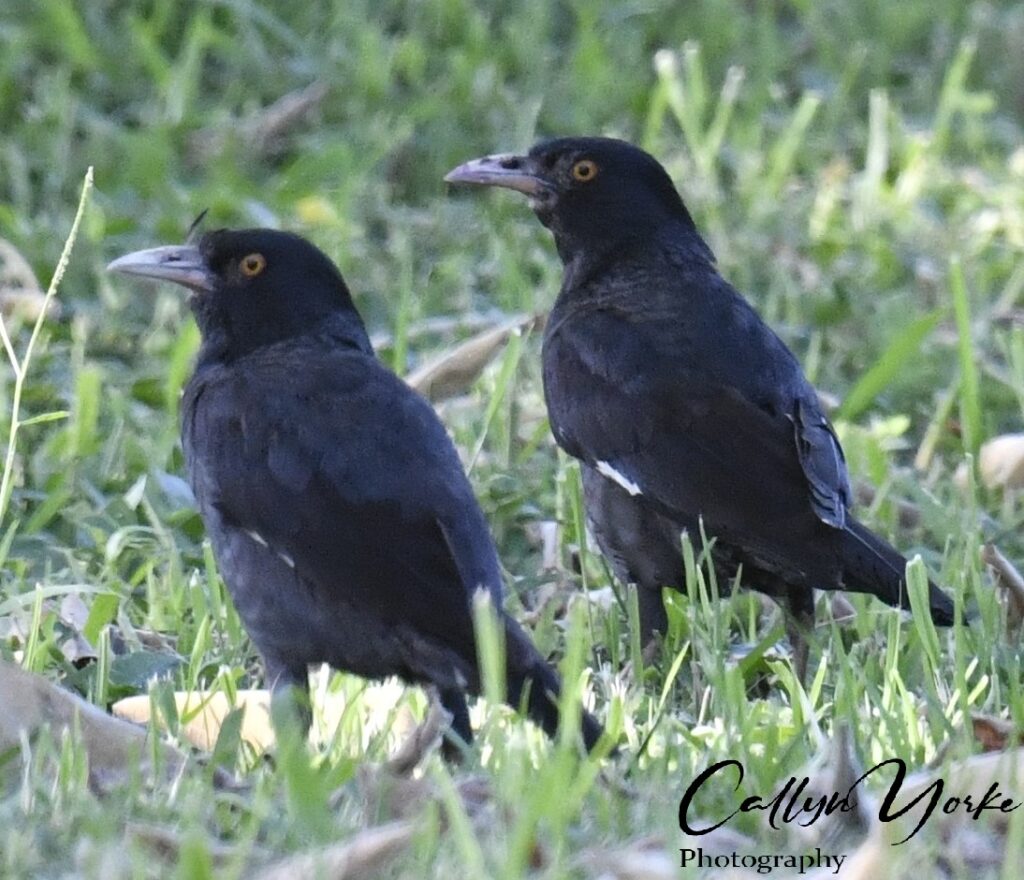
- Oriental Magpie Robin Copsychus saularis 2 vocal, foraging on ground, mostly in shady woodland, C, DFP (photo), TBG.
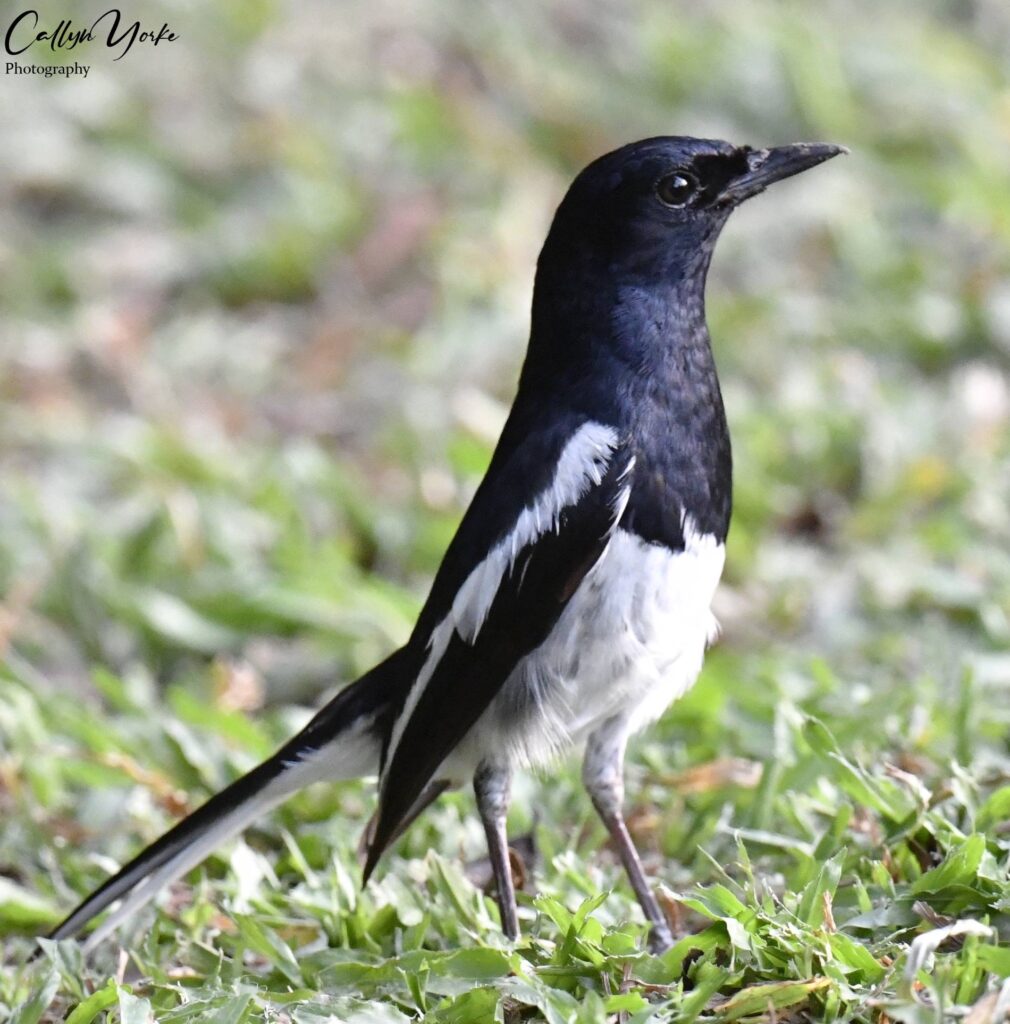
- White-rumped Shama Kittacincla malabarica 1 (m) vocal (a varied, whistled song, repeated), lower-mid level of shady forest, C, TBG (photo).
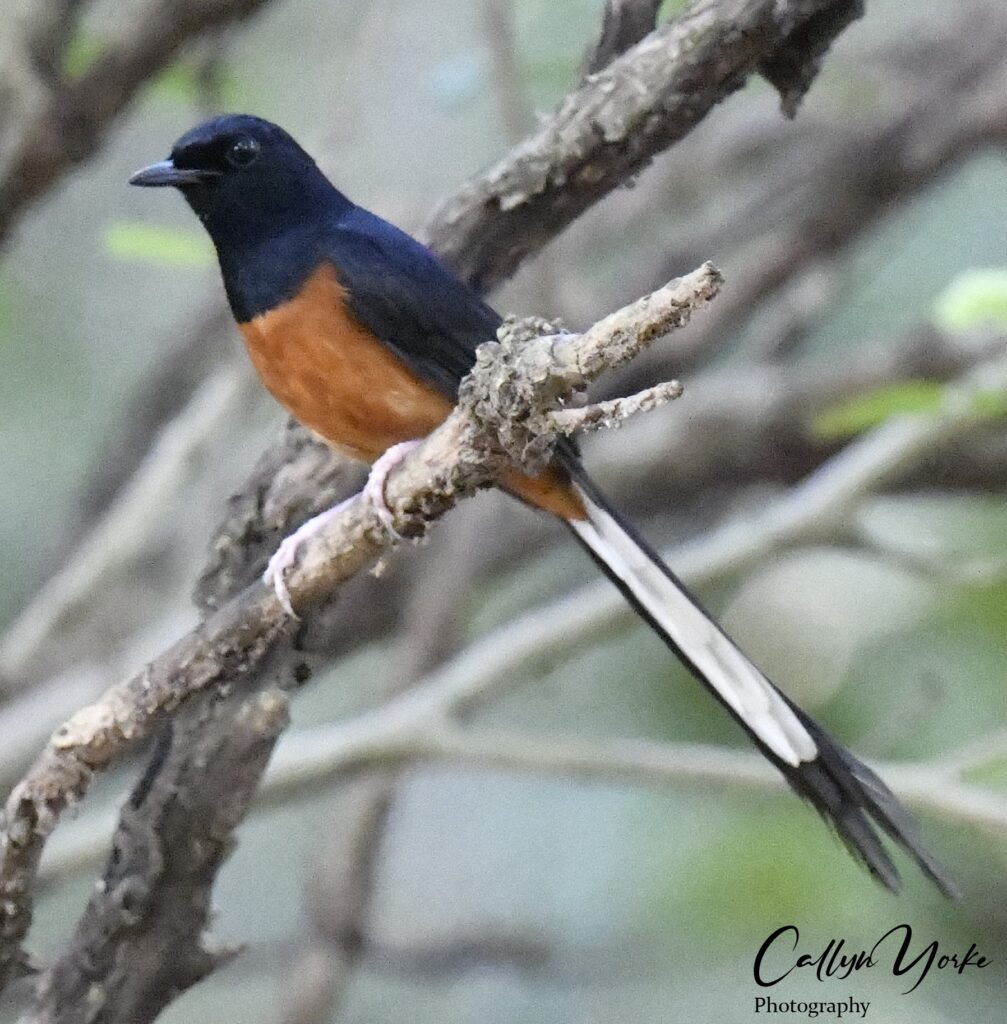
- Plain Flowerpecker Dicaeum minullum 1 seen briefly one late afternoon in a msf with White-vented Bulbul and Swinhoe’s White-eye, UC, DFP.
- Eurasian Tree Sparrow Passer montanus 25 (m,f; ad., imm) vocal, greg. foraging on bare ground in gardens, grassy fields, adjacent to pavement, C, ubiq.